Ағылшын тілі туралы ақпарат

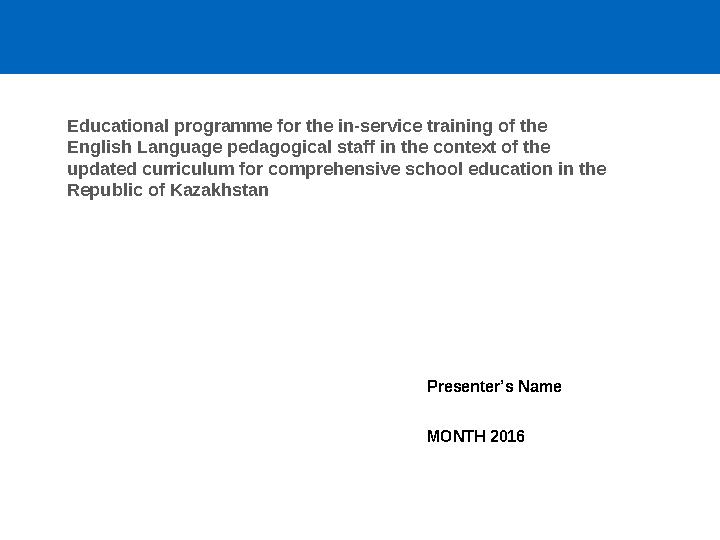



1 слайд
Presenter’s Name
MONTH 2016
Educational programme for the in-service training of the
English Language pedagogical staff in the context of the
updated curriculum for comprehensive school education in the
Republic of Kazakhstan
1 слайд
Presenter’s Name MONTH 2016 Educational programme for the in-service training of the English Language pedagogical staff in the context of the updated curriculum for comprehensive school education in the Republic of Kazakhstan
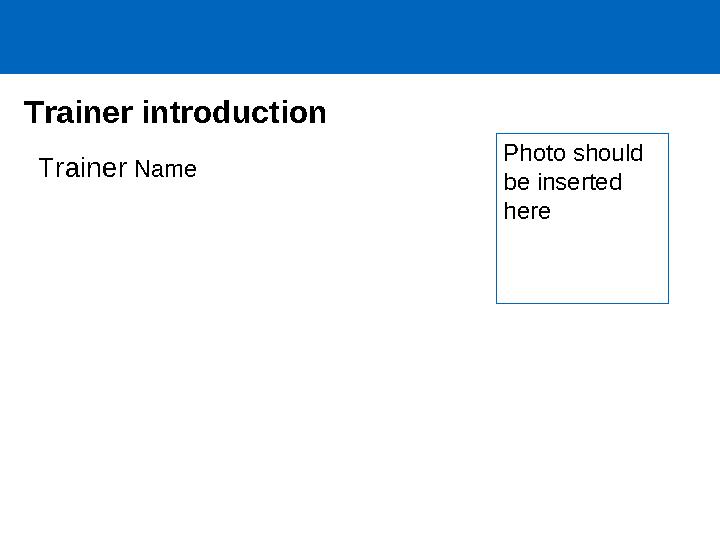
2 слайд
Trainer introduction
Photo should
be inserted
here
Trainer Name
2 слайд
Trainer introduction Photo should be inserted here Trainer Name
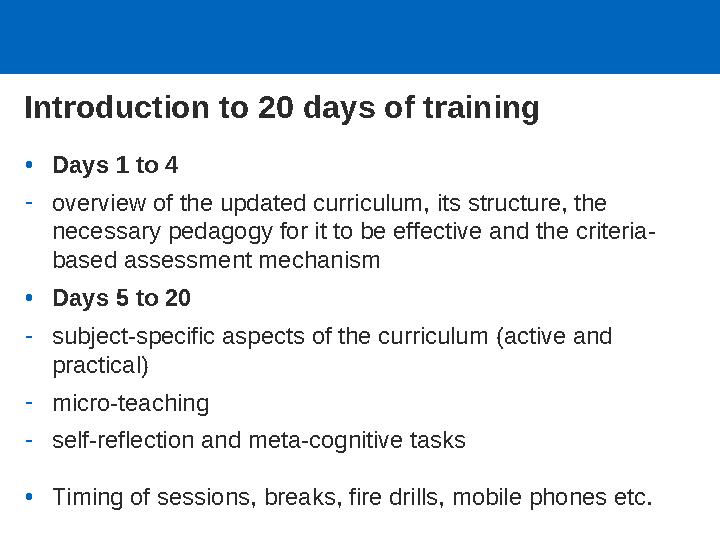
3 слайд
Introduction to 20 days of training
•Days 1 to 4
-overview of the updated curriculum, its structure, the
necessary pedagogy for it to be effective and the criteria-
based assessment mechanism
•Days 5 to 20
-subject-specific aspects of the curriculum (active and
practical)
-micro-teaching
-self-reflection and meta-cognitive tasks
•Timing of sessions, breaks, fire drills, mobile phones etc.
3 слайд
Introduction to 20 days of training •Days 1 to 4 -overview of the updated curriculum, its structure, the necessary pedagogy for it to be effective and the criteria- based assessment mechanism •Days 5 to 20 -subject-specific aspects of the curriculum (active and practical) -micro-teaching -self-reflection and meta-cognitive tasks •Timing of sessions, breaks, fire drills, mobile phones etc.
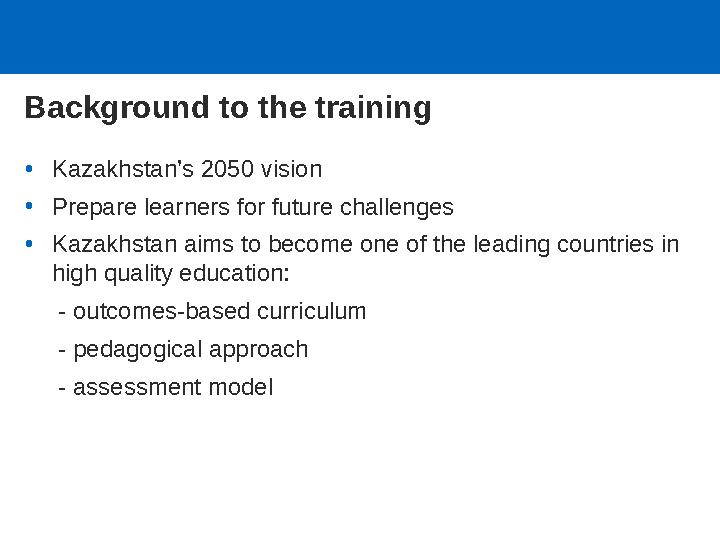
4 слайд
Background to the training
•Kazakhstan’s 2050 vision
•Prepare learners for future challenges
•Kazakhstan aims to become one of the leading countries in
high quality education:
- outcomes-based curriculum
- pedagogical approach
- assessment model
4 слайд
Background to the training •Kazakhstan’s 2050 vision •Prepare learners for future challenges •Kazakhstan aims to become one of the leading countries in high quality education: - outcomes-based curriculum - pedagogical approach - assessment model
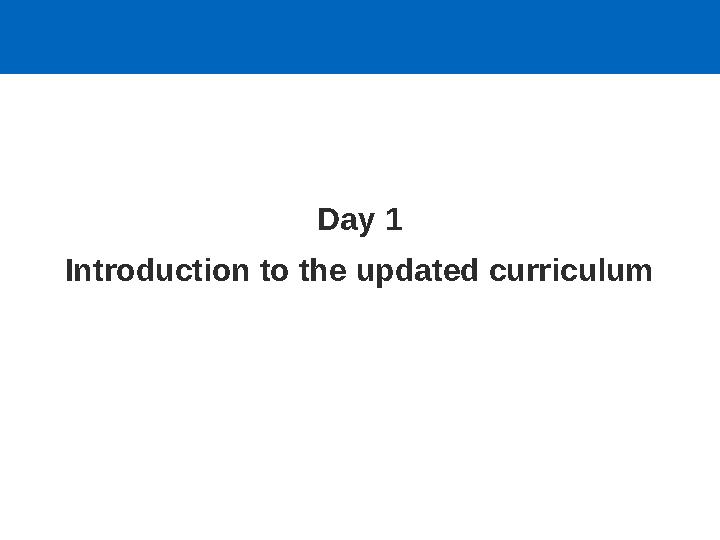
5 слайд
Day 1
Introduction to the updated curriculum
5 слайд
Day 1 Introduction to the updated curriculum
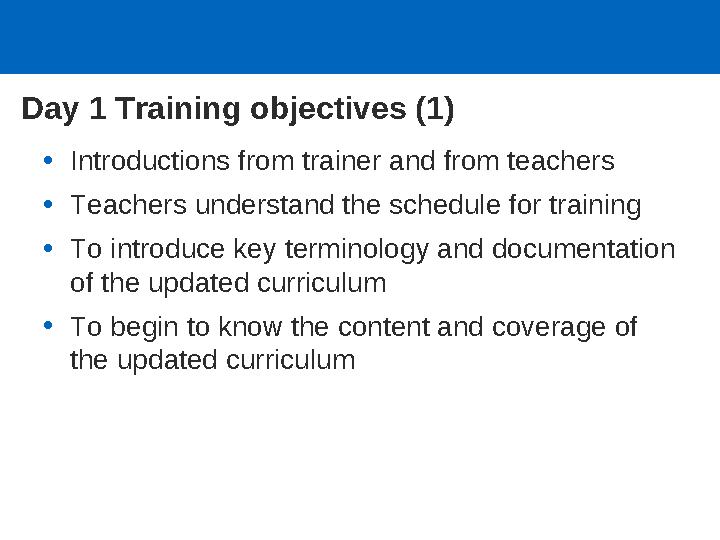
6 слайд
Day 1 Training objectives (1)
•Introductions from trainer and from teachers
•Teachers understand the schedule for training
•To introduce key terminology and documentation
of the updated curriculum
•To begin to know the content and coverage of
the updated curriculum
6 слайд
Day 1 Training objectives (1) •Introductions from trainer and from teachers •Teachers understand the schedule for training •To introduce key terminology and documentation of the updated curriculum •To begin to know the content and coverage of the updated curriculum
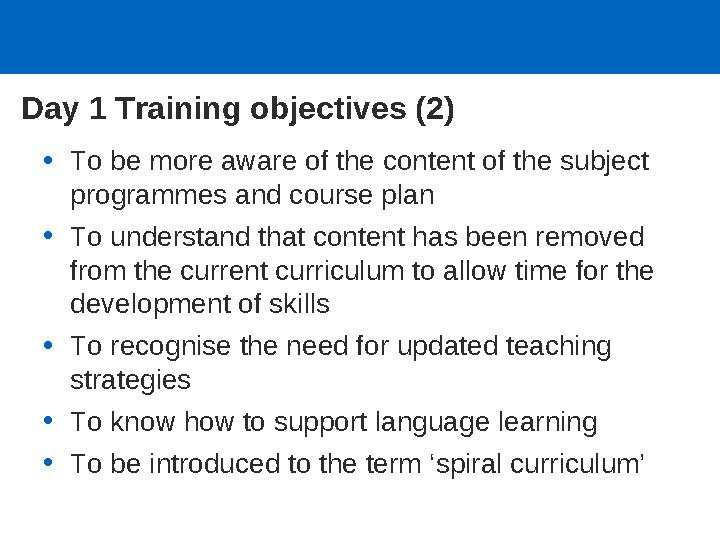
7 слайд
Day 1 Training objectives (2)
•To be more aware of the content of the subject
programmes and course plan
•To understand that content has been removed
from the current curriculum to allow time for the
development of skills
•To recognise the need for updated teaching
strategies
•To know how to support language learning
•To be introduced to the term ‘spiral curriculum’
7 слайд
Day 1 Training objectives (2) •To be more aware of the content of the subject programmes and course plan •To understand that content has been removed from the current curriculum to allow time for the development of skills •To recognise the need for updated teaching strategies •To know how to support language learning •To be introduced to the term ‘spiral curriculum’
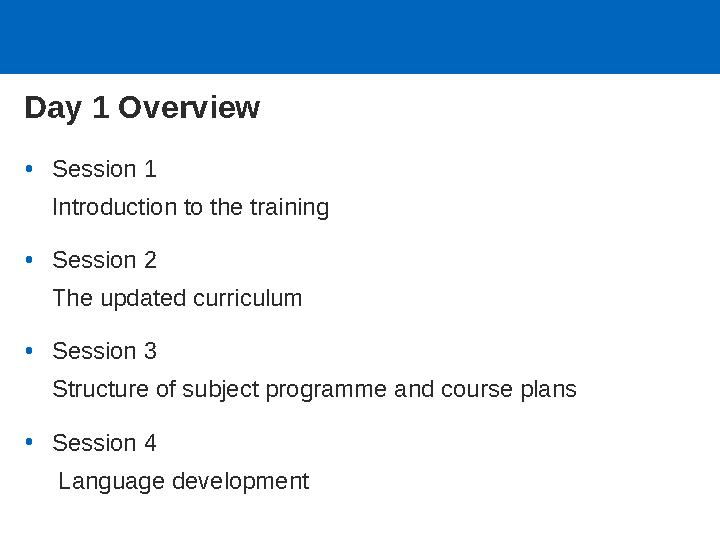
8 слайд
Day 1 Overview
•Session 1
Introduction to the training
•Session 2
The updated curriculum
•Session 3
Structure of subject programme and course plans
•Session 4
Language development
8 слайд
Day 1 Overview •Session 1 Introduction to the training •Session 2 The updated curriculum •Session 3 Structure of subject programme and course plans •Session 4 Language development
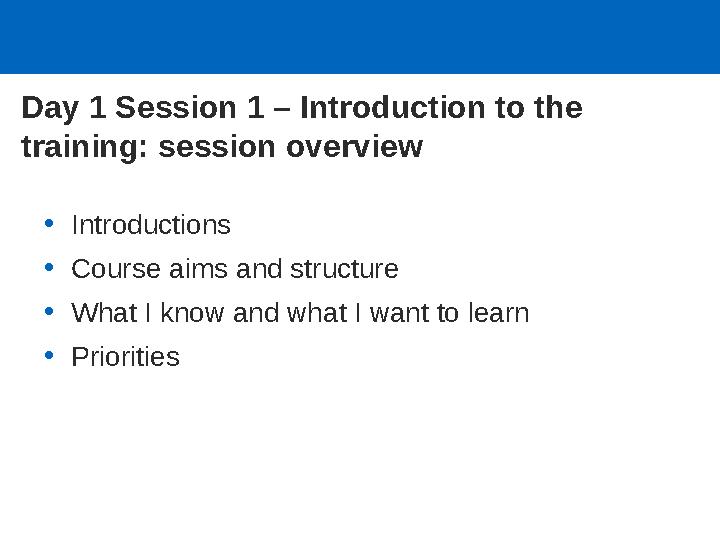
9 слайд
Day 1 Session 1 – Introduction to the
training: session overview
•Introductions
•Course aims and structure
•What I know and what I want to learn
•Priorities
9 слайд
Day 1 Session 1 – Introduction to the training: session overview •Introductions •Course aims and structure •What I know and what I want to learn •Priorities

10 слайд
Day 1 Session 1 – teacher introductions
Introduce yourself to a partner/the whole group
Include at least one interesting piece of information
If you could magically
acquire one new skill,
what would it be?
What have you never done
that you would like to do?
Which adjective best
describes your character?
10 слайд
Day 1 Session 1 – teacher introductions Introduce yourself to a partner/the whole group Include at least one interesting piece of information If you could magically acquire one new skill, what would it be? What have you never done that you would like to do? Which adjective best describes your character?

11 слайд
•Nazarbayev Intellectual Schools (NIS) were introduced in
2011
•NIS have established trilingual schools following an updated
curriculum and assessment model
•They have also implemented innovative educational
practices
•CoE to transfer am updated curriculum, assessment model
and educational practices based on NIS model
•There are three phases of implementation for language
subjects
Day 1 Session 1 – In-service training
programme
11 слайд
•Nazarbayev Intellectual Schools (NIS) were introduced in 2011 •NIS have established trilingual schools following an updated curriculum and assessment model •They have also implemented innovative educational practices •CoE to transfer am updated curriculum, assessment model and educational practices based on NIS model •There are three phases of implementation for language subjects Day 1 Session 1 – In-service training programme
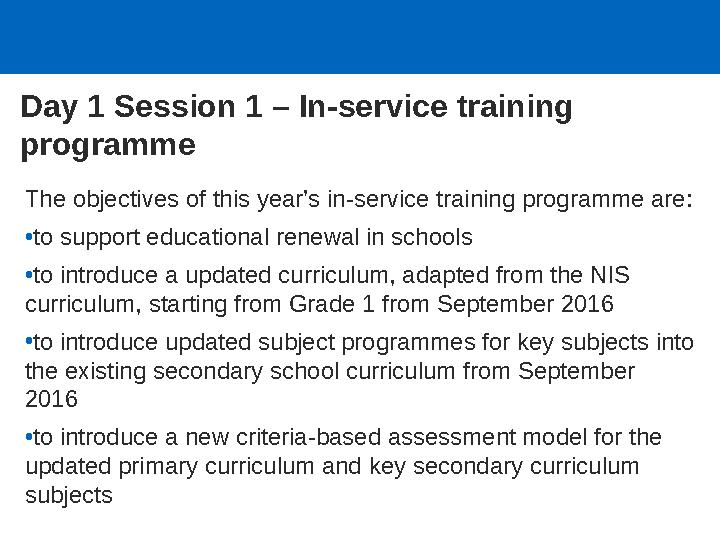
12 слайд
The objectives of this year’s in-service training programme are:
•to support educational renewal in schools
•to introduce a updated curriculum, adapted from the NIS
curriculum, starting from Grade 1 from September 2016
•to introduce updated subject programmes for key subjects into
the existing secondary school curriculum from September
2016
•to introduce a new criteria-based assessment model for the
updated primary curriculum and key secondary curriculum
subjects
Day 1 Session 1 – In-service training
programme
12 слайд
The objectives of this year’s in-service training programme are: •to support educational renewal in schools •to introduce a updated curriculum, adapted from the NIS curriculum, starting from Grade 1 from September 2016 •to introduce updated subject programmes for key subjects into the existing secondary school curriculum from September 2016 •to introduce a new criteria-based assessment model for the updated primary curriculum and key secondary curriculum subjects Day 1 Session 1 – In-service training programme
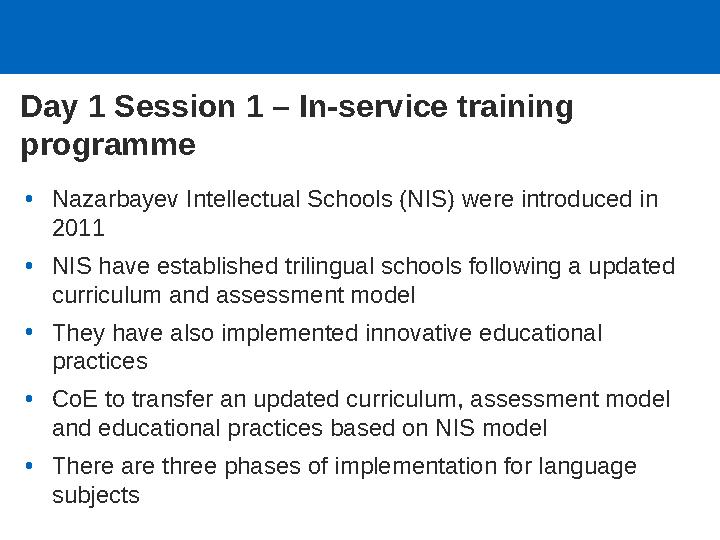
13 слайд
•Nazarbayev Intellectual Schools (NIS) were introduced in
2011
•NIS have established trilingual schools following a updated
curriculum and assessment model
•They have also implemented innovative educational
practices
•CoE to transfer an updated curriculum, assessment model
and educational practices based on NIS model
•There are three phases of implementation for language
subjects
Day 1 Session 1 – In-service training
programme
13 слайд
•Nazarbayev Intellectual Schools (NIS) were introduced in 2011 •NIS have established trilingual schools following a updated curriculum and assessment model •They have also implemented innovative educational practices •CoE to transfer an updated curriculum, assessment model and educational practices based on NIS model •There are three phases of implementation for language subjects Day 1 Session 1 – In-service training programme
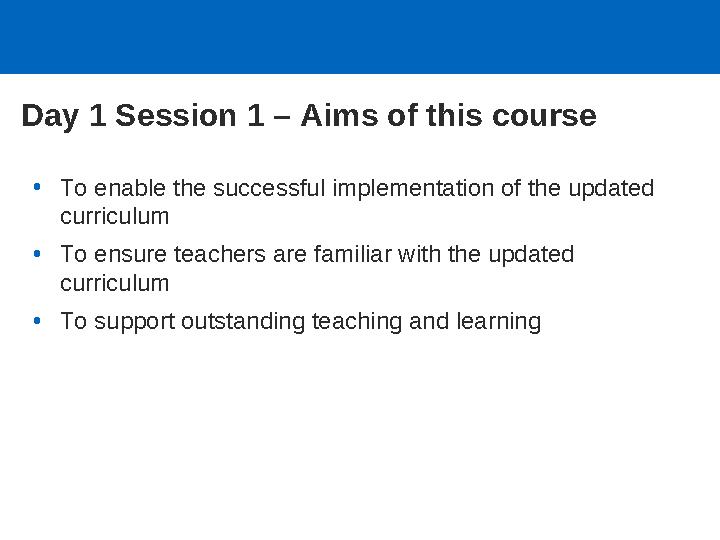
14 слайд
Day 1 Session 1 – Aims of this course
•To enable the successful implementation of the updated
curriculum
•To ensure teachers are familiar with the updated
curriculum
•To support outstanding teaching and learning
14 слайд
Day 1 Session 1 – Aims of this course •To enable the successful implementation of the updated curriculum •To ensure teachers are familiar with the updated curriculum •To support outstanding teaching and learning

15 слайд
Day 1 Session 1 – Course structure
DayTheme of day DayTheme of day
1Introduction to the updated curriculum11Secondary listening and speaking
2Effective teaching and learning 12Developing resources
3Assessment 13Progression and achievement
4Delivering the updated curriculum:
planning and resources
14Planning language lessons
5Language skills 15Engaging learners
6Primary listening and speaking skills16Review of primary resources
7Primary reading and writing skills 17Review of primary resources
8Language classroom management 18Planning and delivering lessons
9Developing learner language awareness 19Planning and delivering lessons
10Secondary reading and writing skills20Key concept review
15 слайд
Day 1 Session 1 – Course structure DayTheme of day DayTheme of day 1Introduction to the updated curriculum11Secondary listening and speaking 2Effective teaching and learning 12Developing resources 3Assessment 13Progression and achievement 4Delivering the updated curriculum: planning and resources 14Planning language lessons 5Language skills 15Engaging learners 6Primary listening and speaking skills16Review of primary resources 7Primary reading and writing skills 17Review of primary resources 8Language classroom management 18Planning and delivering lessons 9Developing learner language awareness 19Planning and delivering lessons 10Secondary reading and writing skills20Key concept review
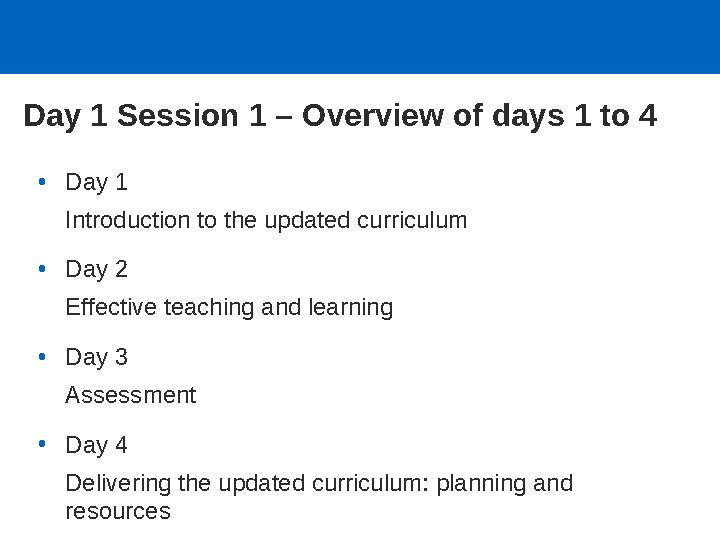
16 слайд
Day 1 Session 1 – Overview of days 1 to 4
•Day 1
Introduction to the updated curriculum
•Day 2
Effective teaching and learning
•Day 3
Assessment
•Day 4
Delivering the updated curriculum: planning and
resources
16 слайд
Day 1 Session 1 – Overview of days 1 to 4 •Day 1 Introduction to the updated curriculum •Day 2 Effective teaching and learning •Day 3 Assessment •Day 4 Delivering the updated curriculum: planning and resources

17 слайд
•What I want to learn handout (individual)
•Priorities (whole group feedback)
•Any outstanding questions?
•Next session
17 слайд
•What I want to learn handout (individual) •Priorities (whole group feedback) •Any outstanding questions? •Next session

18 слайд
End of Session 1
18 слайд
End of Session 1
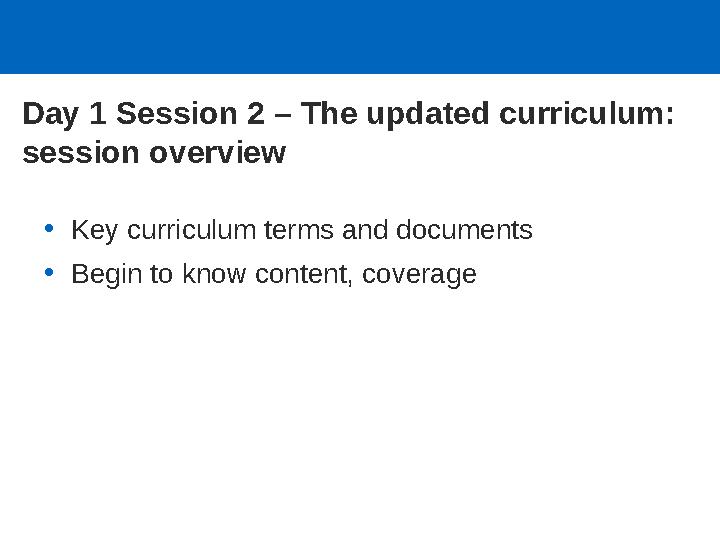
19 слайд
Day 1 Session 2 – The updated curriculum:
session overview
•Key curriculum terms and documents
•Begin to know content, coverage
19 слайд
Day 1 Session 2 – The updated curriculum: session overview •Key curriculum terms and documents •Begin to know content, coverage

20 слайд
All subjects in updated curriculum
•Primary
•Secondary
•High
20 слайд
All subjects in updated curriculum •Primary •Secondary •High

21 слайд
Making connections between key
documents: subject programmes, course
plans and assessment guidance
Learning objectives
Suggested activities
based on learning
objectives
Supports decisions
regarding Formative
Assessment of
learning objectives
Subject programme
Course Plans
Guidance for Formative
Assessment
21 слайд
Making connections between key documents: subject programmes, course plans and assessment guidance Learning objectives Suggested activities based on learning objectives Supports decisions regarding Formative Assessment of learning objectives Subject programme Course Plans Guidance for Formative Assessment

22 слайд
Day 1 Session 2 – Subject programme
contents (1)
Part 1: General information
1.1 The importance of the subject in the curriculum
1.2 The aims of the subject programme
1.3 Implementation of the trilingual policy
1.4 Description of the organisational requirements for the
subject
1.5 Pedagogic approaches for the subject
22 слайд
Day 1 Session 2 – Subject programme contents (1) Part 1: General information 1.1 The importance of the subject in the curriculum 1.2 The aims of the subject programme 1.3 Implementation of the trilingual policy 1.4 Description of the organisational requirements for the subject 1.5 Pedagogic approaches for the subject

23 слайд
Day 1 Session 2 – Subject programme
contents (2)
Part 1: General information (continued)
1.6 Developing respect for diversity of culture and opinion in
the subject
1.7 Competence in the use of digital technologies in the
subject
1.8 Developing communication skills in the subject
1.9 Approaches to assessment in the subject
Part 2: Content
2.1 Subject programme content, organisation and progression
23 слайд
Day 1 Session 2 – Subject programme contents (2) Part 1: General information (continued) 1.6 Developing respect for diversity of culture and opinion in the subject 1.7 Competence in the use of digital technologies in the subject 1.8 Developing communication skills in the subject 1.9 Approaches to assessment in the subject Part 2: Content 2.1 Subject programme content, organisation and progression

24 слайд
Day 1 Session 2 – Course plans: sections
•Long-term plan
•Introduction to language objectives
•Medium-term plan
•Short-term lesson plan
24 слайд
Day 1 Session 2 – Course plans: sections •Long-term plan •Introduction to language objectives •Medium-term plan •Short-term lesson plan
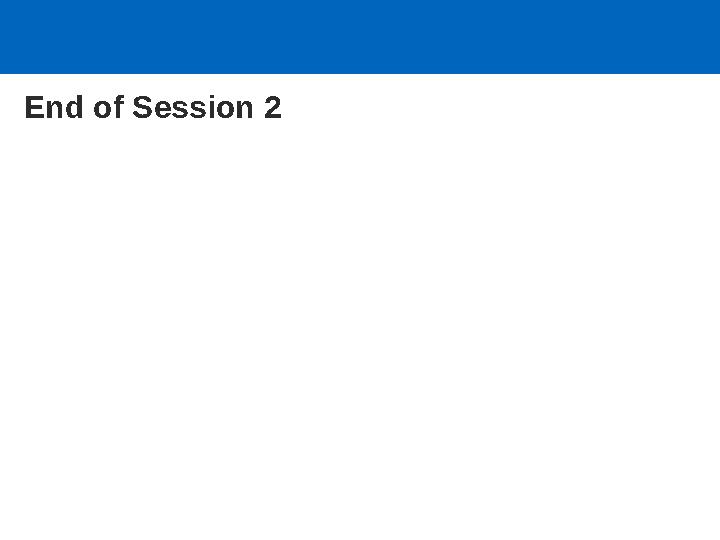
25 слайд
End of Session 2
25 слайд
End of Session 2
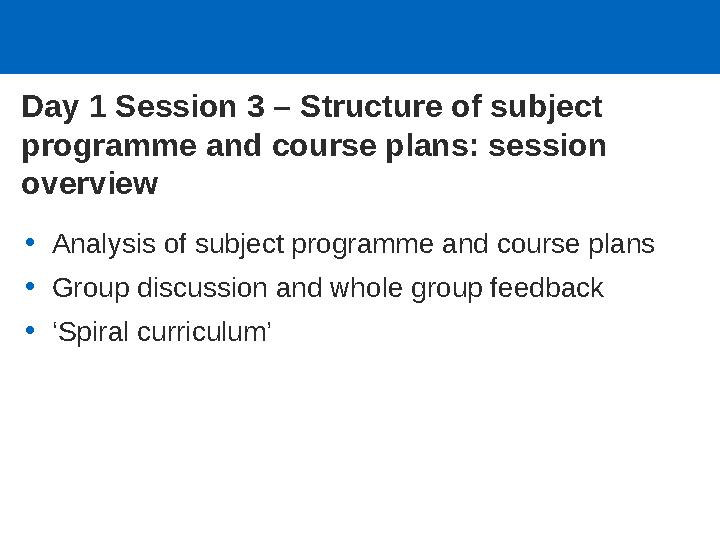
26 слайд
Day 1 Session 3 – Structure of subject
programme and course plans: session
overview
•Analysis of subject programme and course plans
•Group discussion and whole group feedback
•‘Spiral curriculum’
26 слайд
Day 1 Session 3 – Structure of subject programme and course plans: session overview •Analysis of subject programme and course plans •Group discussion and whole group feedback •‘Spiral curriculum’
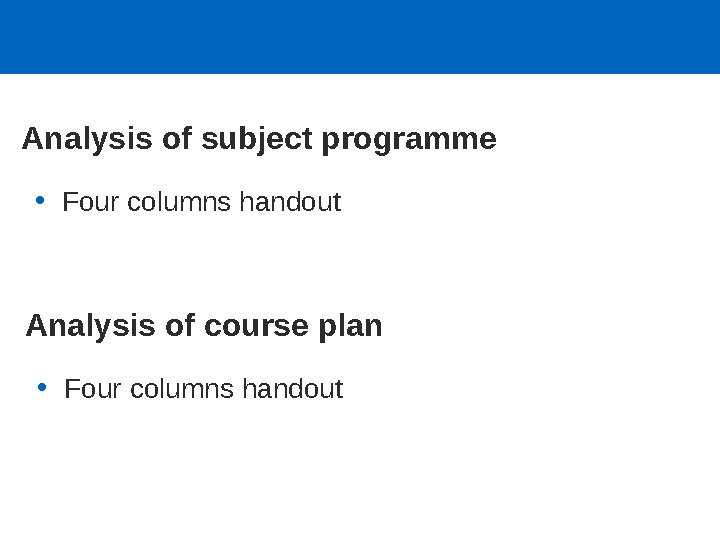
27 слайд
Analysis of subject programme
•Four columns handout
Analysis of course plan
•Four columns handout
27 слайд
Analysis of subject programme •Four columns handout Analysis of course plan •Four columns handout
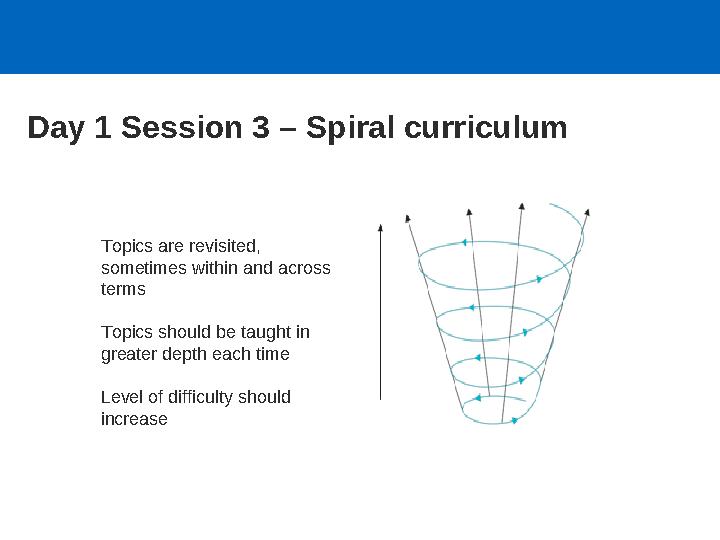
28 слайд
Day 1 Session 3 – Spiral curriculum
Topics are revisited,
sometimes within and across
terms
Topics should be taught in
greater depth each time
Level of difficulty should
increase
28 слайд
Day 1 Session 3 – Spiral curriculum Topics are revisited, sometimes within and across terms Topics should be taught in greater depth each time Level of difficulty should increase
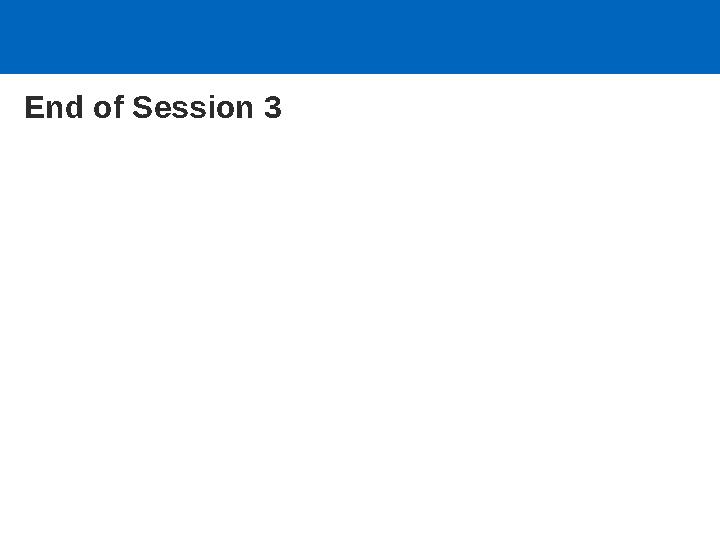
29 слайд
End of Session 3
29 слайд
End of Session 3
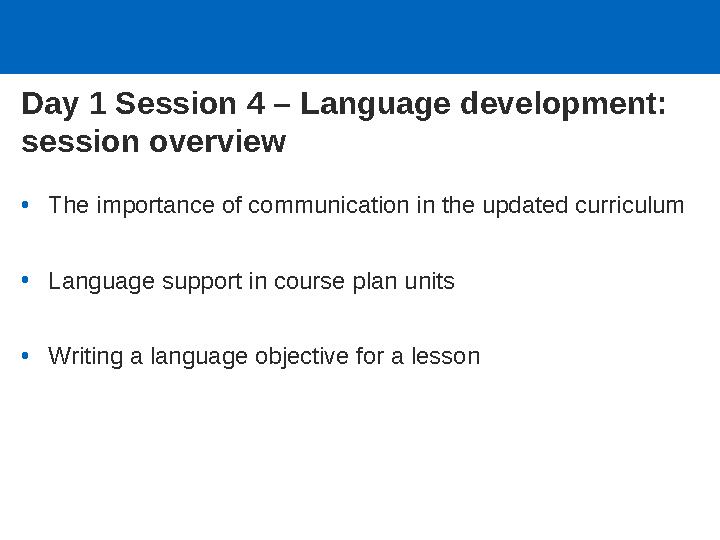
30 слайд
Day 1 Session 4 – Language development:
session overview
•The importance of communication in the updated curriculum
•Language support in course plan units
•Writing a language objective for a lesson
30 слайд
Day 1 Session 4 – Language development: session overview •The importance of communication in the updated curriculum •Language support in course plan units •Writing a language objective for a lesson
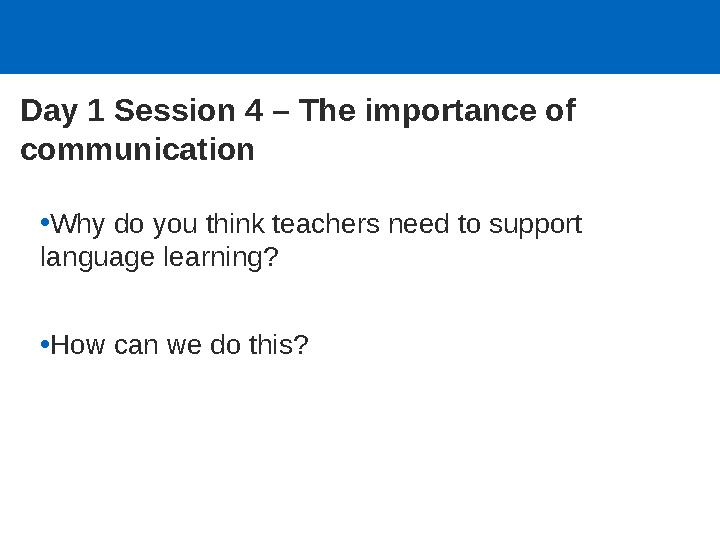
31 слайд
Day 1 Session 4 – The importance of
communication
•Why do you think teachers need to support
language learning?
•How can we do this?
31 слайд
Day 1 Session 4 – The importance of communication •Why do you think teachers need to support language learning? •How can we do this?
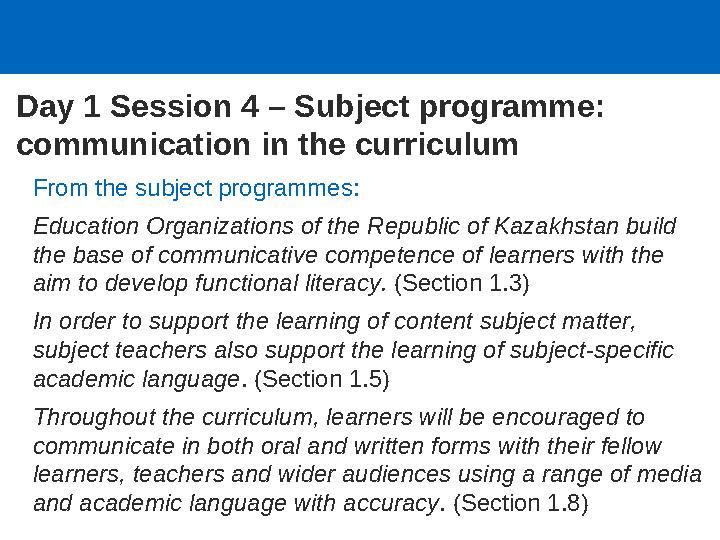
32 слайд
Day 1 Session 4 – Subject programme:
communication in the curriculum
From the subject programmes:
Education Organizations of the Republic of Kazakhstan build
the base of communicative competence of learners with the
aim to develop functional literacy. (Section 1.3)
In order to support the learning of content subject matter,
subject teachers also support the learning of subject-specific
academic language. (Section 1.5)
Throughout the curriculum, learners will be encouraged to
communicate in both oral and written forms with their fellow
learners, teachers and wider audiences using a range of media
and academic language with accuracy. (Section 1.8)
32 слайд
Day 1 Session 4 – Subject programme: communication in the curriculum From the subject programmes: Education Organizations of the Republic of Kazakhstan build the base of communicative competence of learners with the aim to develop functional literacy. (Section 1.3) In order to support the learning of content subject matter, subject teachers also support the learning of subject-specific academic language. (Section 1.5) Throughout the curriculum, learners will be encouraged to communicate in both oral and written forms with their fellow learners, teachers and wider audiences using a range of media and academic language with accuracy. (Section 1.8)
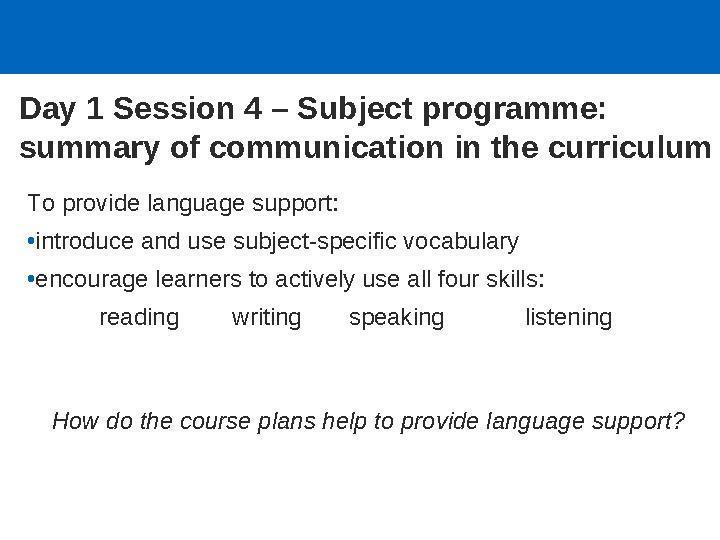
33 слайд
Day 1 Session 4 – Subject programme:
summary of communication in the curriculum
To provide language support:
•introduce and use subject-specific vocabulary
•encourage learners to actively use all four skills:
reading writing speaking listening
How do the course plans help to provide language support?
33 слайд
Day 1 Session 4 – Subject programme: summary of communication in the curriculum To provide language support: •introduce and use subject-specific vocabulary •encourage learners to actively use all four skills: reading writing speaking listening How do the course plans help to provide language support?
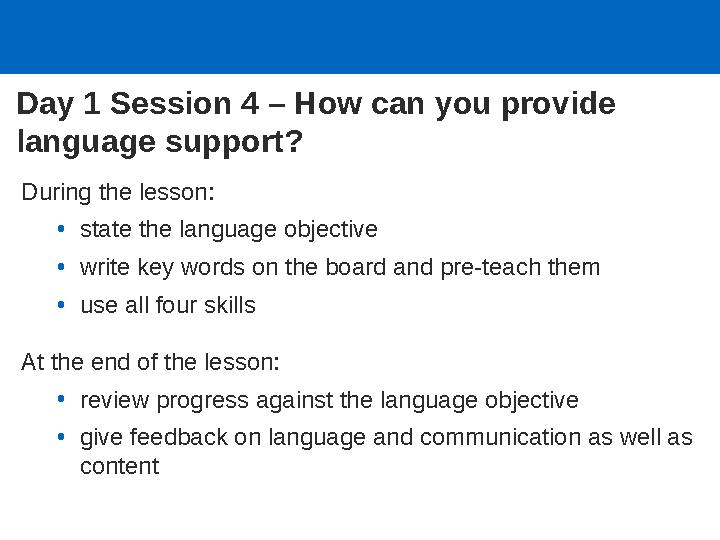
34 слайд
Day 1 Session 4 – How can you provide
language support?
During the lesson:
•state the language objective
•write key words on the board and pre-teach them
•use all four skills
At the end of the lesson:
•review progress against the language objective
•give feedback on language and communication as well as
content
34 слайд
Day 1 Session 4 – How can you provide language support? During the lesson: •state the language objective •write key words on the board and pre-teach them •use all four skills At the end of the lesson: •review progress against the language objective •give feedback on language and communication as well as content
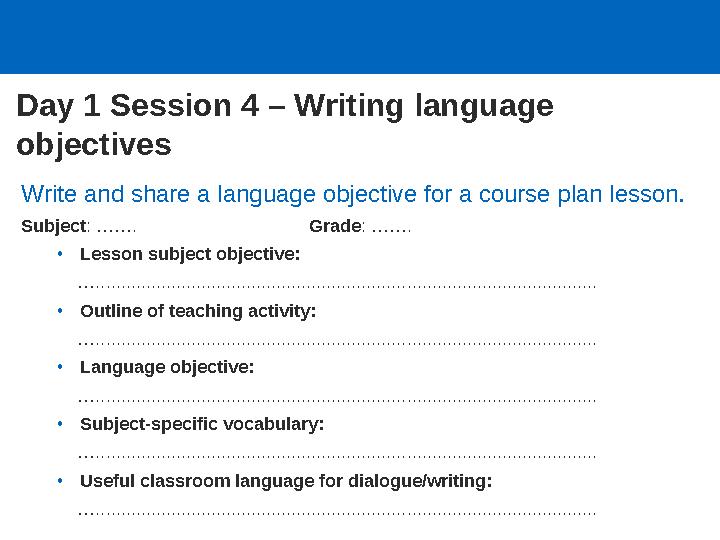
35 слайд
Day 1 Session 4 – Writing language
objectives
Write and share a language objective for a course plan lesson.
Subject: ……. Grade: …….
•Lesson subject objective:
…....................................................................................................
•Outline of teaching activity:
…....................................................................................................
•Language objective:
…....................................................................................................
•Subject-specific vocabulary:
…....................................................................................................
•Useful classroom language for dialogue/writing:
…....................................................................................................
35 слайд
Day 1 Session 4 – Writing language objectives Write and share a language objective for a course plan lesson. Subject: ……. Grade: ……. •Lesson subject objective: ….................................................................................................... •Outline of teaching activity: ….................................................................................................... •Language objective: ….................................................................................................... •Subject-specific vocabulary: ….................................................................................................... •Useful classroom language for dialogue/writing: …....................................................................................................
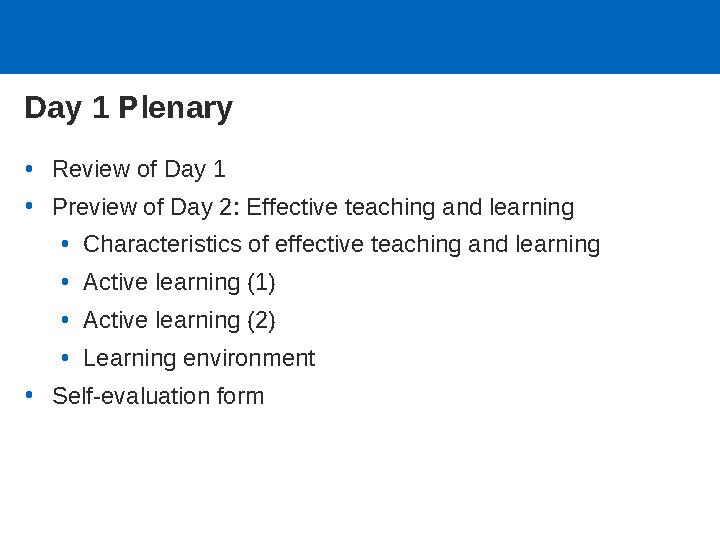
36 слайд
Day 1 Plenary
•Review of Day 1
•Preview of Day 2: Effective teaching and learning
•Characteristics of effective teaching and learning
•Active learning (1)
•Active learning (2)
•Learning environment
•Self-evaluation form
36 слайд
Day 1 Plenary •Review of Day 1 •Preview of Day 2: Effective teaching and learning •Characteristics of effective teaching and learning •Active learning (1) •Active learning (2) •Learning environment •Self-evaluation form
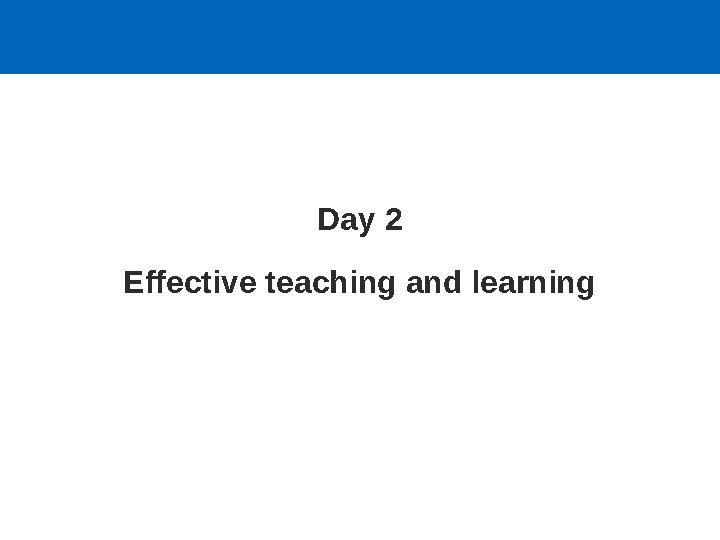
37 слайд
Day 2
Effective teaching and learning
37 слайд
Day 2 Effective teaching and learning

38 слайд
Day 2 Training objectives
•To be aware of the characteristics of effective teaching and
learning
•To know the pedagogical approach to be taken as identified
in the subject programmes
•To participate in an active learning activity
•To understand what active learning is
•To incorporate active learning principles into teaching
activities
•To know that learning should be objective led, not activity
driven
38 слайд
Day 2 Training objectives •To be aware of the characteristics of effective teaching and learning •To know the pedagogical approach to be taken as identified in the subject programmes •To participate in an active learning activity •To understand what active learning is •To incorporate active learning principles into teaching activities •To know that learning should be objective led, not activity driven
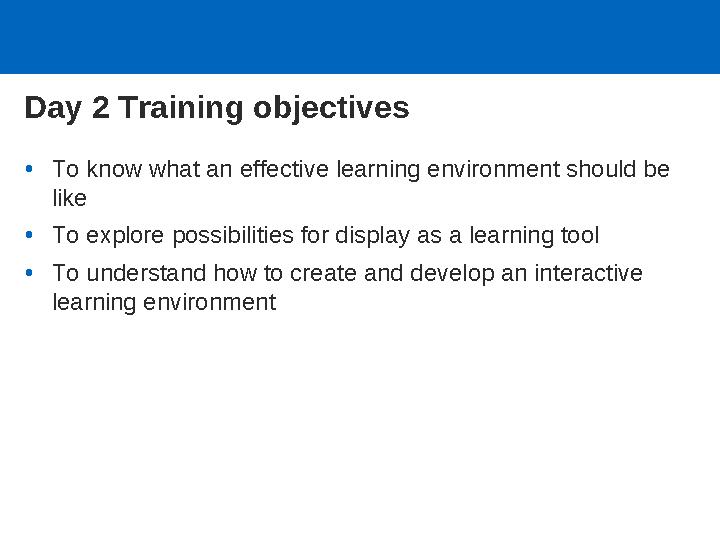
39 слайд
Day 2 Training objectives
•To know what an effective learning environment should be
like
•To explore possibilities for display as a learning tool
•To understand how to create and develop an interactive
learning environment
39 слайд
Day 2 Training objectives •To know what an effective learning environment should be like •To explore possibilities for display as a learning tool •To understand how to create and develop an interactive learning environment
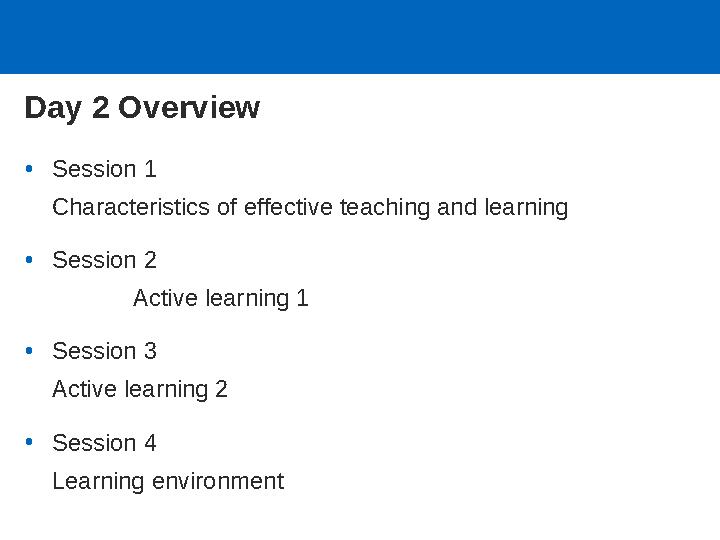
40 слайд
Day 2 Overview
•Session 1
Characteristics of effective teaching and learning
•Session 2
Active learning 1
•Session 3
Active learning 2
•Session 4
Learning environment
40 слайд
Day 2 Overview •Session 1 Characteristics of effective teaching and learning •Session 2 Active learning 1 •Session 3 Active learning 2 •Session 4 Learning environment
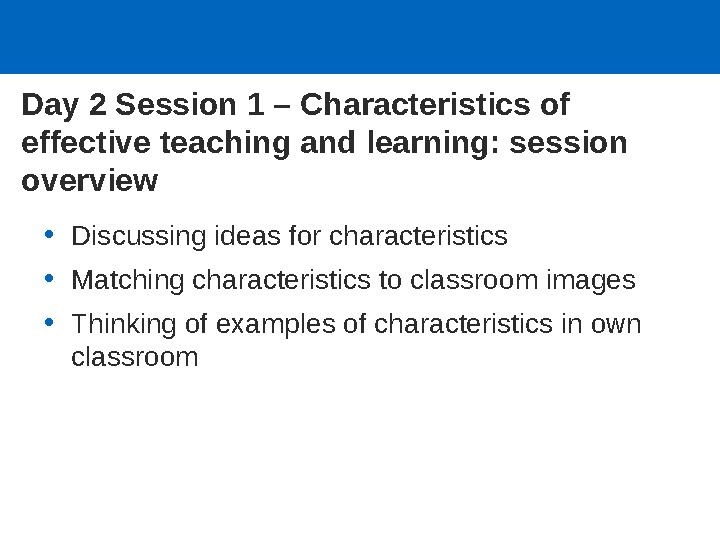
41 слайд
Day 2 Session 1 – Characteristics of
effective teaching and learning: session
overview
•Discussing ideas for characteristics
•Matching characteristics to classroom images
•Thinking of examples of characteristics in own
classroom
41 слайд
Day 2 Session 1 – Characteristics of effective teaching and learning: session overview •Discussing ideas for characteristics •Matching characteristics to classroom images •Thinking of examples of characteristics in own classroom

42 слайд
Day 2 Session 1 – What are the
characteristics of effective teaching and
learning?
Discussion in pairs
List five characteristics of effective teaching and learning
Share ideas in small groups
42 слайд
Day 2 Session 1 – What are the characteristics of effective teaching and learning? Discussion in pairs List five characteristics of effective teaching and learning Share ideas in small groups

43 слайд
Day 2 Session 1 – Some characteristics of
effective teaching and learning
In pairs, match these pictures to possible characteristics listed
on the handout
C
B
A
D
43 слайд
Day 2 Session 1 – Some characteristics of effective teaching and learning In pairs, match these pictures to possible characteristics listed on the handout C B A D

44 слайд
Day 2 Session 1 – Some characteristics of
effective teaching and learning
In pairs, match these pictures to possible characteristics listed
on the handout
G
F
E
G
H
44 слайд
Day 2 Session 1 – Some characteristics of effective teaching and learning In pairs, match these pictures to possible characteristics listed on the handout G F E G H

45 слайд
Day 2 Session 1 – 1 Active learning
Learning from own experiences:
•Allows learners to experiment,
construct meaning and develop
understanding
•Relates new knowledge to existing
knowledge
•Making mistakes makes us check
and refine our understanding
•Results in deeper learning
•Changes attitudes
Picture F
45 слайд
Day 2 Session 1 – 1 Active learning Learning from own experiences: •Allows learners to experiment, construct meaning and develop understanding •Relates new knowledge to existing knowledge •Making mistakes makes us check and refine our understanding •Results in deeper learning •Changes attitudes Picture F

46 слайд
Structured group work:
•Improves interpersonal and
communication skills
•Improves acquisition of information
and higher-level thinking skills
•Promotes positive interdependence
– ‘we succeed together’
•Can break down barriers between
learners
Day 2 Session 1 – 2 Collaborative learning
Picture B
46 слайд
Structured group work: •Improves interpersonal and communication skills •Improves acquisition of information and higher-level thinking skills •Promotes positive interdependence – ‘we succeed together’ •Can break down barriers between learners Day 2 Session 1 – 2 Collaborative learning Picture B
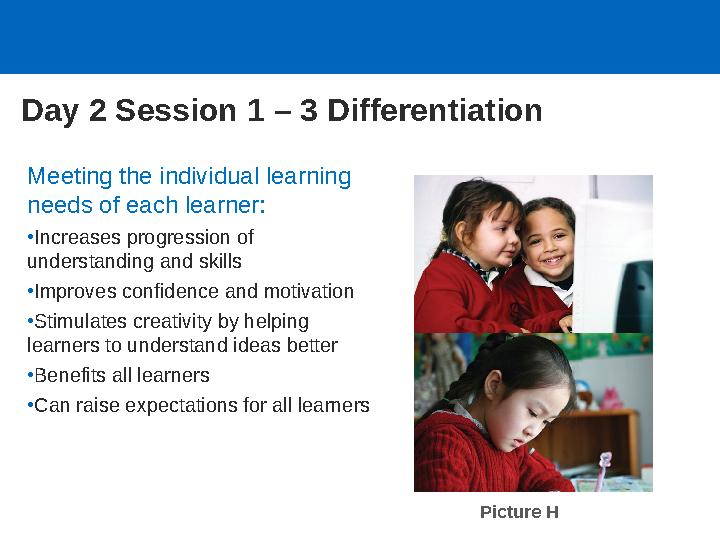
47 слайд
Meeting the individual learning
needs of each learner:
•Increases progression of
understanding and skills
•Improves confidence and motivation
•Stimulates creativity by helping
learners to understand ideas better
•Benefits all learners
•Can raise expectations for all learners
Day 2 Session 1 – 3 Differentiation
Picture H
47 слайд
Meeting the individual learning needs of each learner: •Increases progression of understanding and skills •Improves confidence and motivation •Stimulates creativity by helping learners to understand ideas better •Benefits all learners •Can raise expectations for all learners Day 2 Session 1 – 3 Differentiation Picture H

48 слайд
Day 2 Session 1 – 4 Cross-curricular links
Creating links between subjects:
•Adds breadth and balance to the
curriculum
•Allows deeper learning
•Provides a broader range of skills
•Can help with progression of
understanding and skills
•Can help to put learning into a more
meaningful context
•Can make learning more motivating
Picture C
48 слайд
Day 2 Session 1 – 4 Cross-curricular links Creating links between subjects: •Adds breadth and balance to the curriculum •Allows deeper learning •Provides a broader range of skills •Can help with progression of understanding and skills •Can help to put learning into a more meaningful context •Can make learning more motivating Picture C
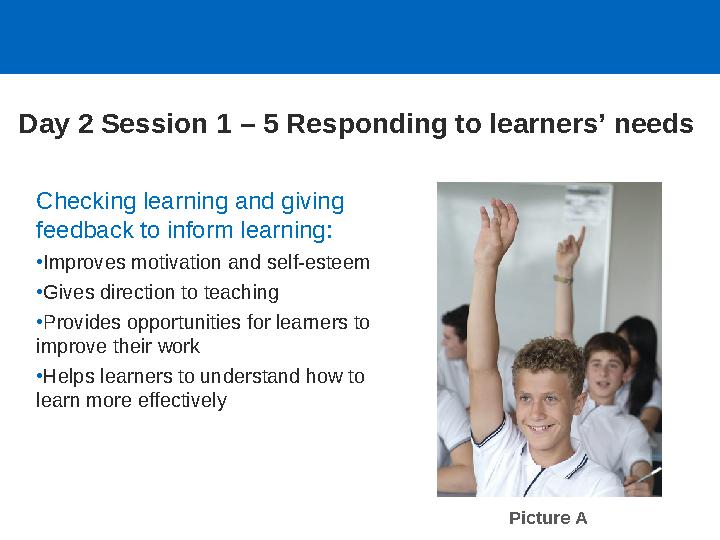
49 слайд
Checking learning and giving
feedback to inform learning:
•Improves motivation and self-esteem
•Gives direction to teaching
•Provides opportunities for learners to
improve their work
•Helps learners to understand how to
learn more effectively
Day 2 Session 1 – 5 Responding to learners’ needs
Picture A
49 слайд
Checking learning and giving feedback to inform learning: •Improves motivation and self-esteem •Gives direction to teaching •Provides opportunities for learners to improve their work •Helps learners to understand how to learn more effectively Day 2 Session 1 – 5 Responding to learners’ needs Picture A
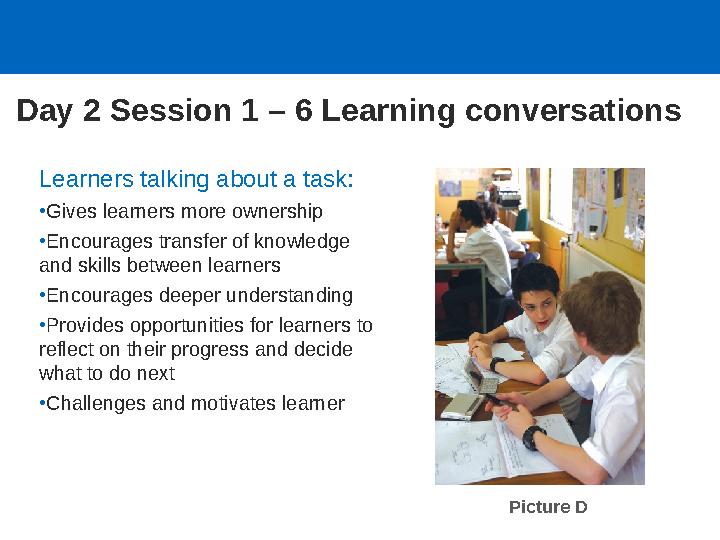
50 слайд
Learners talking about a task:
•Gives learners more ownership
•Encourages transfer of knowledge
and skills between learners
•Encourages deeper understanding
•Provides opportunities for learners to
reflect on their progress and decide
what to do next
•Challenges and motivates learner
Day 2 Session 1 – 6 Learning conversations
Picture D
50 слайд
Learners talking about a task: •Gives learners more ownership •Encourages transfer of knowledge and skills between learners •Encourages deeper understanding •Provides opportunities for learners to reflect on their progress and decide what to do next •Challenges and motivates learner Day 2 Session 1 – 6 Learning conversations Picture D

51 слайд
Using technology:
•Offers exciting tools for active
learning
•Can be motivating
•Can be used to research,
communicate, collaborate and create
•Can give learners more ownership of
a task by allowing them to search for
information and find their own tools
•Allows opportunities for learning
outside the classroom
Day 2 Session 1 – 7 Using e-learning and new technology
Picture G
51 слайд
Using technology: •Offers exciting tools for active learning •Can be motivating •Can be used to research, communicate, collaborate and create •Can give learners more ownership of a task by allowing them to search for information and find their own tools •Allows opportunities for learning outside the classroom Day 2 Session 1 – 7 Using e-learning and new technology Picture G

52 слайд
Day 2 Session 1 – 8 Modelling
An expert giving an example whilst
explaining their accompanying
thought processes:
•Exposes learners to subject content and
expert thinking simultaneously
•Breaks a task into steps, allowing
learners to become increasingly
independent
•Stimulates reflection on the processes
Picture E
52 слайд
Day 2 Session 1 – 8 Modelling An expert giving an example whilst explaining their accompanying thought processes: •Exposes learners to subject content and expert thinking simultaneously •Breaks a task into steps, allowing learners to become increasingly independent •Stimulates reflection on the processes Picture E

53 слайд
Day 2 Session 1
In pairs
•How do these characteristics compare with the ‘Pedagogic
approach’ section of the subject programme?
Whole group discussion
•How is the approach similar/different to what occurs in your
schools now?
•What are the issues in implementing these approaches?
•How can we address these?
53 слайд
Day 2 Session 1 In pairs •How do these characteristics compare with the ‘Pedagogic approach’ section of the subject programme? Whole group discussion •How is the approach similar/different to what occurs in your schools now? •What are the issues in implementing these approaches? •How can we address these?
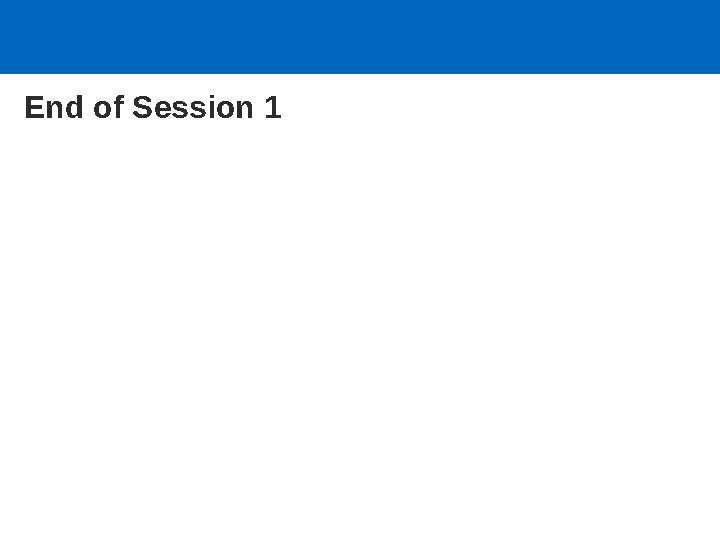
54 слайд
End of Session 1
54 слайд
End of Session 1
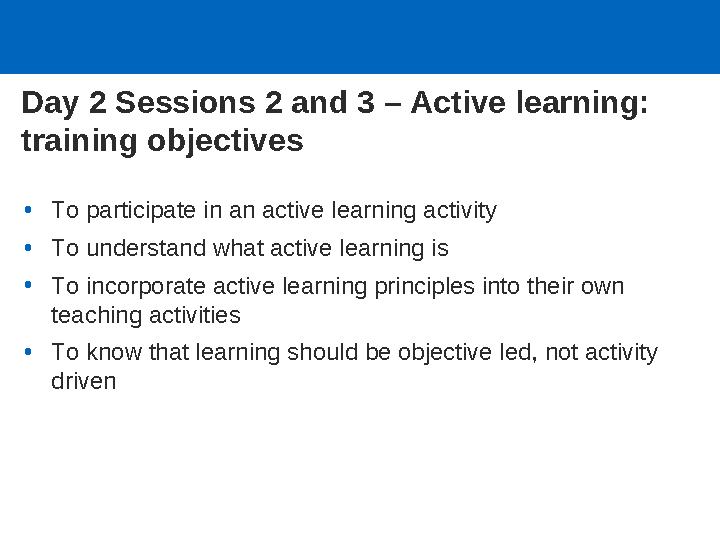
55 слайд
Day 2 Sessions 2 and 3 – Active learning:
training objectives
•To participate in an active learning activity
•To understand what active learning is
•To incorporate active learning principles into their own
teaching activities
•To know that learning should be objective led, not activity
driven
55 слайд
Day 2 Sessions 2 and 3 – Active learning: training objectives •To participate in an active learning activity •To understand what active learning is •To incorporate active learning principles into their own teaching activities •To know that learning should be objective led, not activity driven
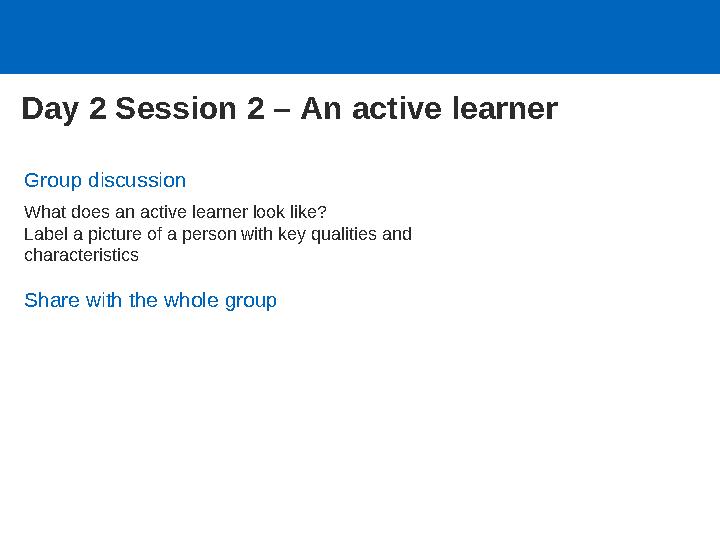
56 слайд
Group discussion
What does an active learner look like?
Label a picture of a person with key qualities and
characteristics
Share with the whole group
Day 2 Session 2 – An active learner
56 слайд
Group discussion What does an active learner look like? Label a picture of a person with key qualities and characteristics Share with the whole group Day 2 Session 2 – An active learner

57 слайд
What does an active teacher look like?
Day 2 Session 2 – An active teacher
57 слайд
What does an active teacher look like? Day 2 Session 2 – An active teacher

58 слайд
Day 2 Session 2 – An active teacher: Active learning
principles 1
To enable progress:
•Repeat learning objectives
•Present different activities
•Practise skills
•Build on prior learning
58 слайд
Day 2 Session 2 – An active teacher: Active learning principles 1 To enable progress: •Repeat learning objectives •Present different activities •Practise skills •Build on prior learning

59 слайд
Day 2 Session 2 – An active teacher: Active learning
principles 2
To support learning:
•Promote curiosity
•Ask questions
•Experiment
•Suggest
•Invent
•Teach to learning styles
59 слайд
Day 2 Session 2 – An active teacher: Active learning principles 2 To support learning: •Promote curiosity •Ask questions •Experiment •Suggest •Invent •Teach to learning styles

60 слайд
Make sure resources are:
•Organised
•Accessible
•Shared
•Familiar
•Made
•Used regularly
•Built up over time
•Good quality
Day 2 Session 2 – An active teacher: Active learning
principles 3
60 слайд
Make sure resources are: •Organised •Accessible •Shared •Familiar •Made •Used regularly •Built up over time •Good quality Day 2 Session 2 – An active teacher: Active learning principles 3
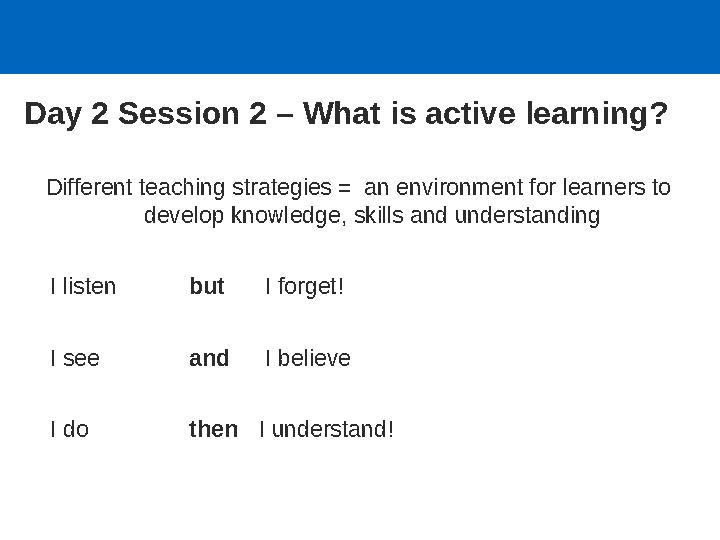
61 слайд
Different teaching strategies = an environment for learners to
develop knowledge, skills and understanding
I listen but I forget!
I see and I believe
I do thenI understand!
Day 2 Session 2 – What is active learning?
61 слайд
Different teaching strategies = an environment for learners to develop knowledge, skills and understanding I listen but I forget! I see and I believe I do thenI understand! Day 2 Session 2 – What is active learning?
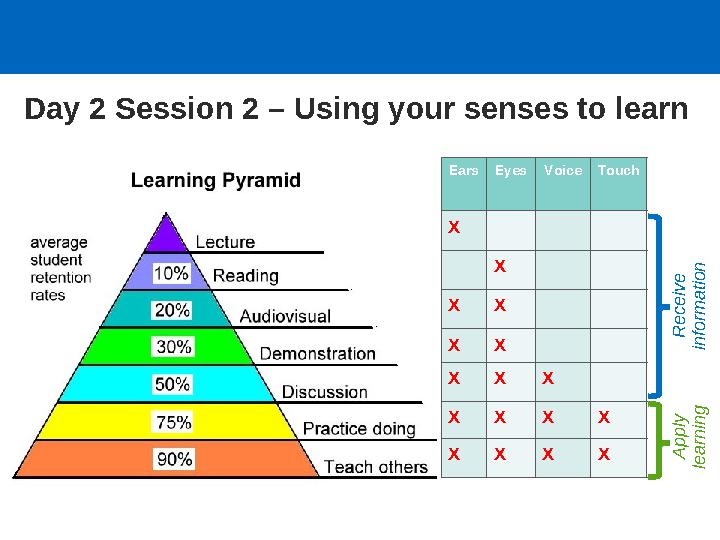
62 слайд
EarsEyesVoiceTouch
X
X
X X
X X
X X X
X X X X
X X X X
R
e
c
e
iv
e
in
f
o
r
m
a
t
io
n
A
p
p
ly
le
a
r
n
in
g
Day 2 Session 2 – Using your senses to learn
62 слайд
EarsEyesVoiceTouch X X X X X X X X X X X X X X X X X R e c e iv e in f o r m a t io n A p p ly le a r n in g Day 2 Session 2 – Using your senses to learn

63 слайд
•Learning by doing
•Having FUN learning!
Active learning is …
Day 2 Session 2
63 слайд
•Learning by doing •Having FUN learning! Active learning is … Day 2 Session 2
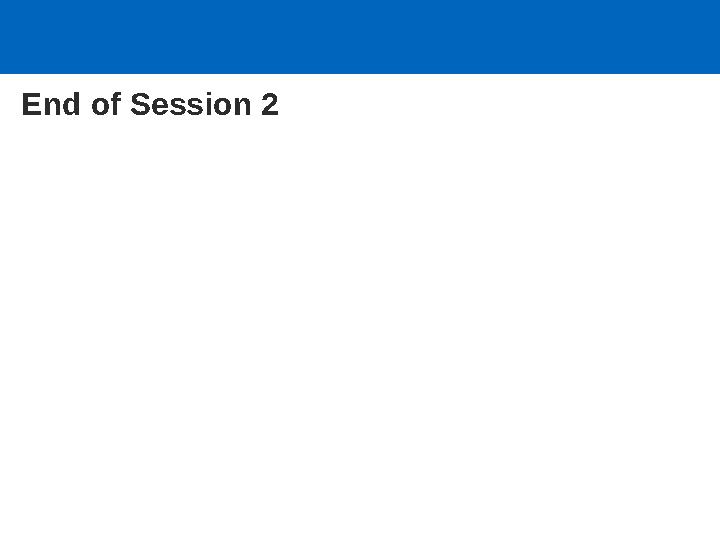
64 слайд
End of Session 2
64 слайд
End of Session 2

65 слайд
Day 2 Session 3 – Training objectives
•To incorporate active learning principles into their
own teaching activities
•To know that learning should be objective led, not
activity driven
65 слайд
Day 2 Session 3 – Training objectives •To incorporate active learning principles into their own teaching activities •To know that learning should be objective led, not activity driven
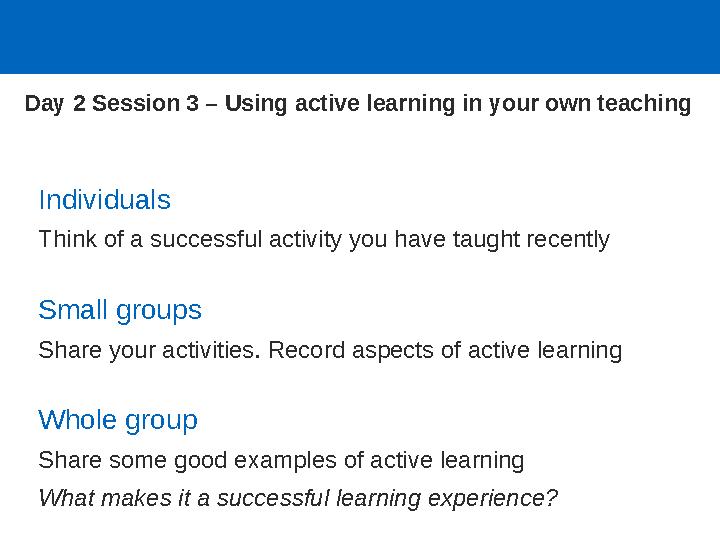
66 слайд
Individuals
Think of a successful activity you have taught recently
Small groups
Share your activities. Record aspects of active learning
Whole group
Share some good examples of active learning
What makes it a successful learning experience?
Day 2 Session 3 – Using active learning in your own teaching
66 слайд
Individuals Think of a successful activity you have taught recently Small groups Share your activities. Record aspects of active learning Whole group Share some good examples of active learning What makes it a successful learning experience? Day 2 Session 3 – Using active learning in your own teaching

67 слайд
Possible reasons
•To identify gaps in learning
•To direct learner’s thinking
•To assess
•To prompt further questions
•To revise a topic
•To excite interest or curiosity
•To challenge
•To model questioning and
thinking
•To help clarify understanding
•To evaluate
Day 2 Session 3 –
1. Why do we ask questions?
67 слайд
Possible reasons •To identify gaps in learning •To direct learner’s thinking •To assess •To prompt further questions •To revise a topic •To excite interest or curiosity •To challenge •To model questioning and thinking •To help clarify understanding •To evaluate Day 2 Session 3 – 1. Why do we ask questions?
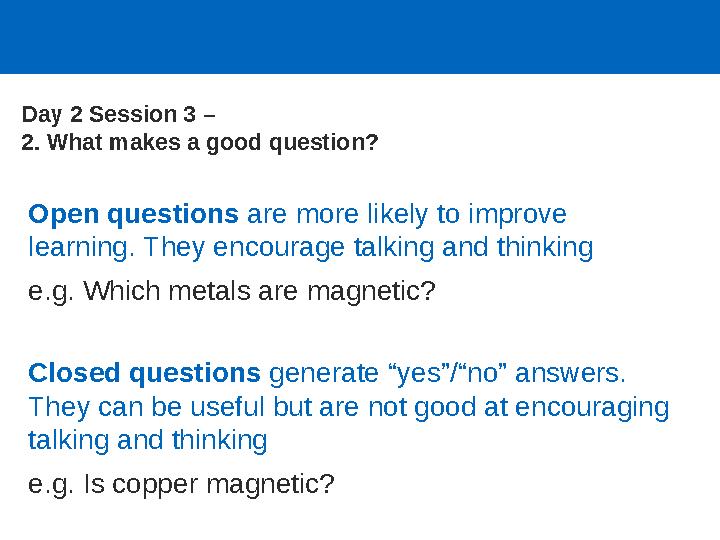
68 слайд
Open questions are more likely to improve
learning. They encourage talking and thinking
e.g. Which metals are magnetic?
Closed questions generate “yes”/“no” answers.
They can be useful but are not good at encouraging
talking and thinking
e.g. Is copper magnetic?
Day 2 Session 3 –
2. What makes a good question?
68 слайд
Open questions are more likely to improve learning. They encourage talking and thinking e.g. Which metals are magnetic? Closed questions generate “yes”/“no” answers. They can be useful but are not good at encouraging talking and thinking e.g. Is copper magnetic? Day 2 Session 3 – 2. What makes a good question?

69 слайд
Day 3 Session 4 –
2. What makes a good question?
General open questions
•How can we …?
•How did you …?
•What would happen if …?
•Tell me about …?
•What do you think about …?
Complete the questions to make questions you might ask in
your classroom
69 слайд
Day 3 Session 4 – 2. What makes a good question? General open questions •How can we …? •How did you …? •What would happen if …? •Tell me about …? •What do you think about …? Complete the questions to make questions you might ask in your classroom
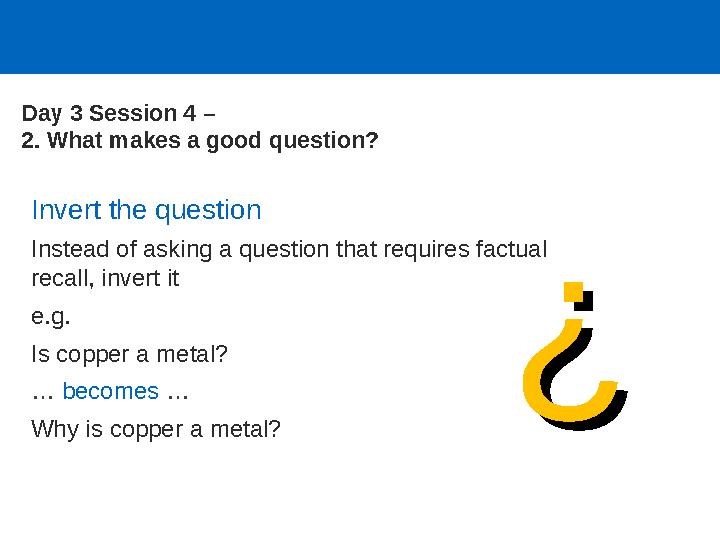
70 слайд
Invert the question
Instead of asking a question that requires factual
recall, invert it
e.g.
Is copper a metal?
… becomes …
Why is copper a metal?
Day 3 Session 4 –
2. What makes a good question?
??
70 слайд
Invert the question Instead of asking a question that requires factual recall, invert it e.g. Is copper a metal? … becomes … Why is copper a metal? Day 3 Session 4 – 2. What makes a good question? ??
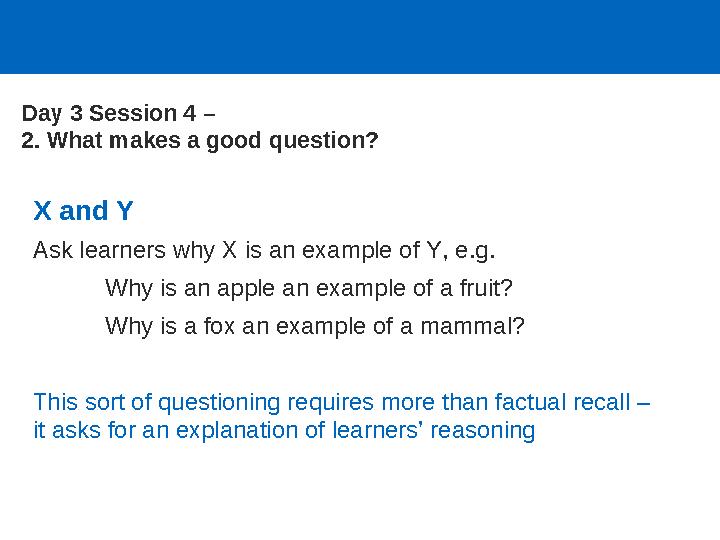
71 слайд
X and Y
Ask learners why X is an example of Y, e.g.
Why is an apple an example of a fruit?
Why is a fox an example of a mammal?
This sort of questioning requires more than factual recall –
it asks for an explanation of learners’ reasoning
Day 3 Session 4 –
2. What makes a good question?
71 слайд
X and Y Ask learners why X is an example of Y, e.g. Why is an apple an example of a fruit? Why is a fox an example of a mammal? This sort of questioning requires more than factual recall – it asks for an explanation of learners’ reasoning Day 3 Session 4 – 2. What makes a good question?

72 слайд
Learners asking questions
Create opportunities for learners to ask questions:
•ask the teacher
•ask each other
•a ‘question box’ for written questions provides a
different way for learners to be able to ask
questions
Day 2 Session 3 –
3. Who asks the questions?
72 слайд
Learners asking questions Create opportunities for learners to ask questions: •ask the teacher •ask each other •a ‘question box’ for written questions provides a different way for learners to be able to ask questions Day 2 Session 3 – 3. Who asks the questions?
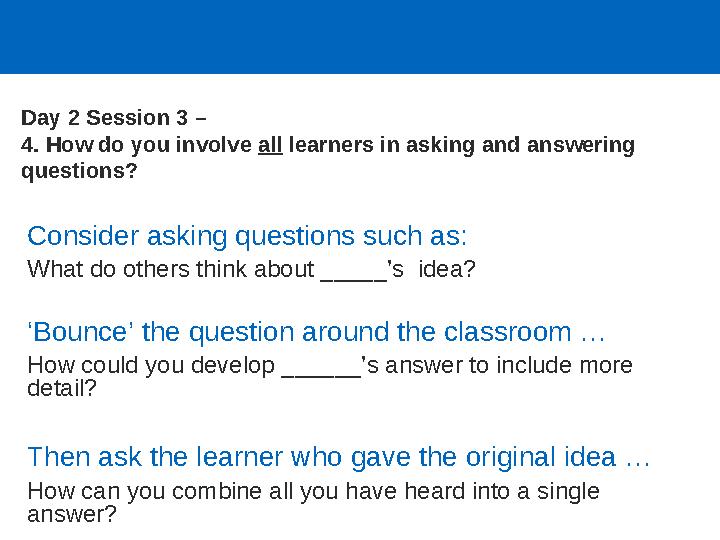
73 слайд
Consider asking questions such as:
What do others think about _____’s idea?
‘Bounce’ the question around the classroom …
How could you develop ______’s answer to include more
detail?
Then ask the learner who gave the original idea …
How can you combine all you have heard into a single
answer?
Day 2 Session 3 –
4. How do you involve all learners in asking and answering
questions?
73 слайд
Consider asking questions such as: What do others think about _____’s idea? ‘Bounce’ the question around the classroom … How could you develop ______’s answer to include more detail? Then ask the learner who gave the original idea … How can you combine all you have heard into a single answer? Day 2 Session 3 – 4. How do you involve all learners in asking and answering questions?
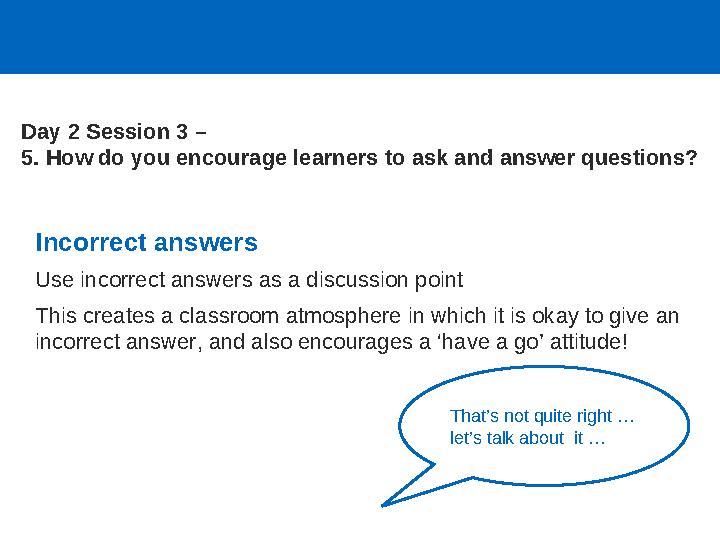
74 слайд
Incorrect answers
Use incorrect answers as a discussion point
This creates a classroom atmosphere in which it is okay to give an
incorrect answer, and also encourages a ‘have a go’ attitude!
Day 2 Session 3 –
5. How do you encourage learners to ask and answer questions?
That’s not quite right …
let’s talk about it …
74 слайд
Incorrect answers Use incorrect answers as a discussion point This creates a classroom atmosphere in which it is okay to give an incorrect answer, and also encourages a ‘have a go’ attitude! Day 2 Session 3 – 5. How do you encourage learners to ask and answer questions? That’s not quite right … let’s talk about it …
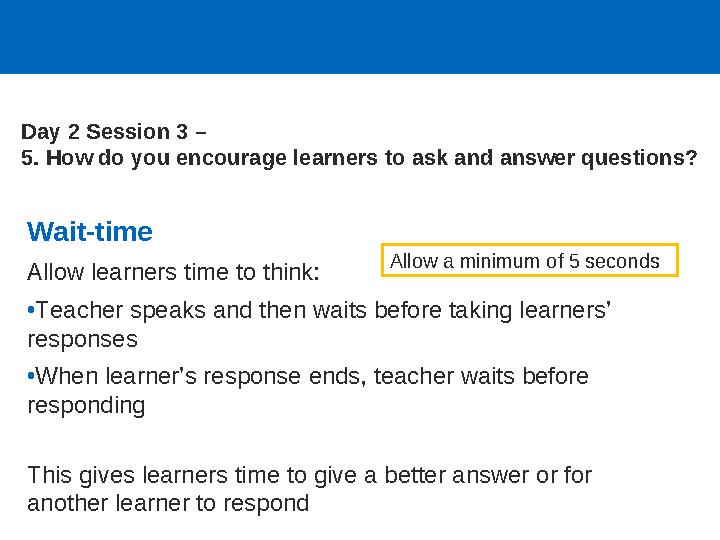
75 слайд
Wait-time
Allow learners time to think:
•Teacher speaks and then waits before taking learners’
responses
•When learner’s response ends, teacher waits before
responding
This gives learners time to give a better answer or for
another learner to respond
Allow a minimum of 5 seconds
Day 2 Session 3 –
5. How do you encourage learners to ask and answer questions?
75 слайд
Wait-time Allow learners time to think: •Teacher speaks and then waits before taking learners’ responses •When learner’s response ends, teacher waits before responding This gives learners time to give a better answer or for another learner to respond Allow a minimum of 5 seconds Day 2 Session 3 – 5. How do you encourage learners to ask and answer questions?
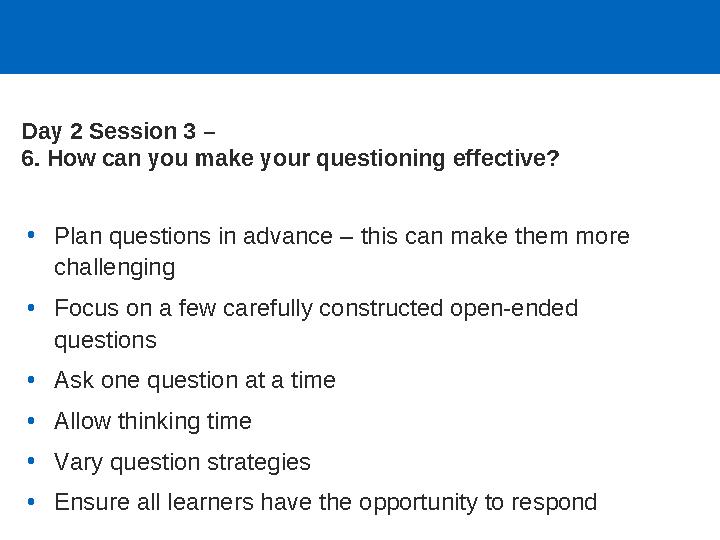
76 слайд
•Plan questions in advance – this can make them more
challenging
•Focus on a few carefully constructed open-ended
questions
•Ask one question at a time
•Allow thinking time
•Vary question strategies
•Ensure all learners have the opportunity to respond
Day 2 Session 3 –
6. How can you make your questioning effective?
76 слайд
•Plan questions in advance – this can make them more challenging •Focus on a few carefully constructed open-ended questions •Ask one question at a time •Allow thinking time •Vary question strategies •Ensure all learners have the opportunity to respond Day 2 Session 3 – 6. How can you make your questioning effective?
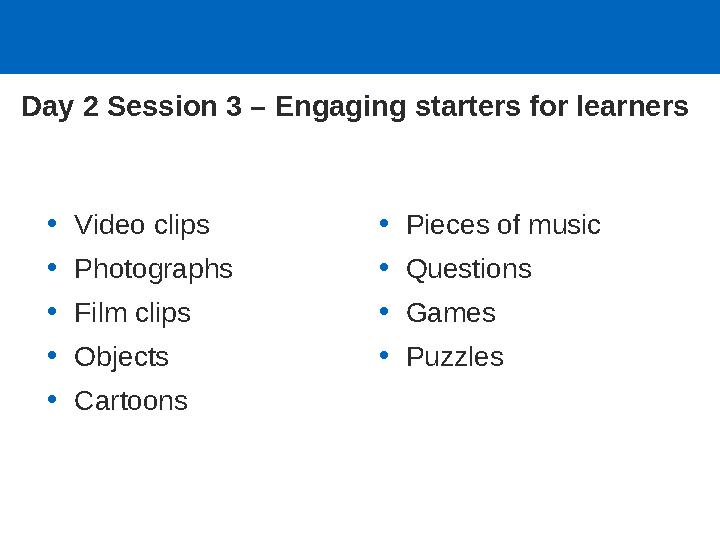
77 слайд
•Video clips
•Photographs
•Film clips
•Objects
•Cartoons
•Pieces of music
•Questions
•Games
•Puzzles
Day 2 Session 3 – Engaging starters for learners
77 слайд
•Video clips •Photographs •Film clips •Objects •Cartoons •Pieces of music •Questions •Games •Puzzles Day 2 Session 3 – Engaging starters for learners

78 слайд
End of Session 3
78 слайд
End of Session 3

79 слайд
Day 2 Session 4 – Learning environments:
objectives
•To know what an effective learning environment
should be like
•To explore possibilities for display as a learning tool
•To understand how to create and develop an
interactive learning environment
79 слайд
Day 2 Session 4 – Learning environments: objectives •To know what an effective learning environment should be like •To explore possibilities for display as a learning tool •To understand how to create and develop an interactive learning environment
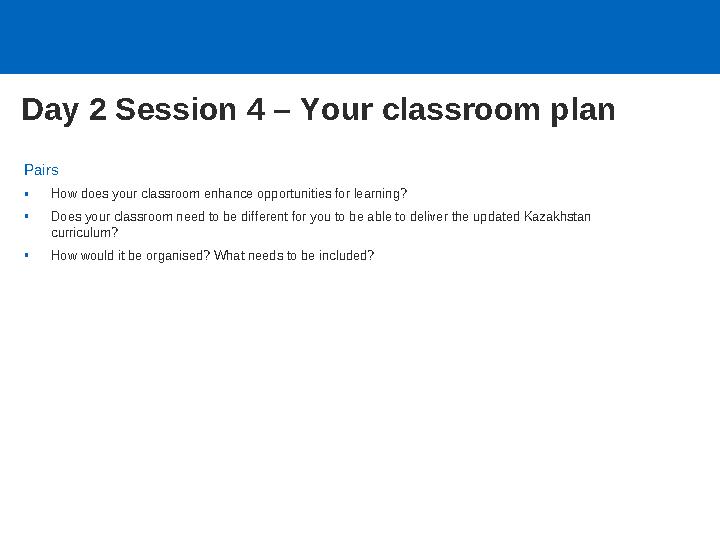
80 слайд
Pairs
•How does your classroom enhance opportunities for learning?
•Does your classroom need to be different for you to be able to deliver the updated Kazakhstan
curriculum?
•How would it be organised? What needs to be included?
Day 2 Session 4 – Your classroom plan
80 слайд
Pairs •How does your classroom enhance opportunities for learning? •Does your classroom need to be different for you to be able to deliver the updated Kazakhstan curriculum? •How would it be organised? What needs to be included? Day 2 Session 4 – Your classroom plan
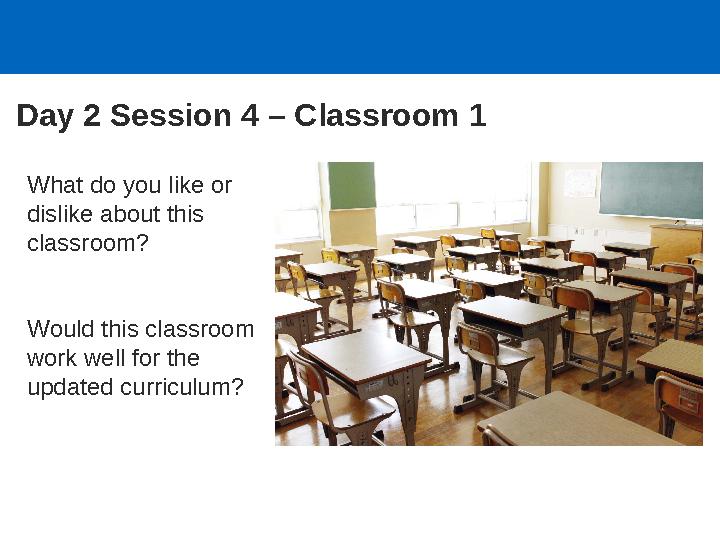
81 слайд
Day 2 Session 4 – Classroom 1
What do you like or
dislike about this
classroom?
Would this classroom
work well for the
updated curriculum?
81 слайд
Day 2 Session 4 – Classroom 1 What do you like or dislike about this classroom? Would this classroom work well for the updated curriculum?
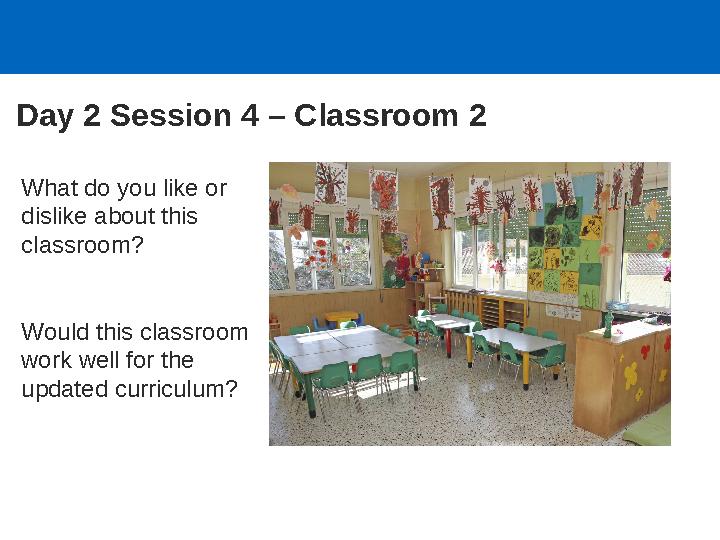
82 слайд
Day 2 Session 4 – Classroom 2
What do you like or
dislike about this
classroom?
Would this classroom
work well for the
updated curriculum?
82 слайд
Day 2 Session 4 – Classroom 2 What do you like or dislike about this classroom? Would this classroom work well for the updated curriculum?
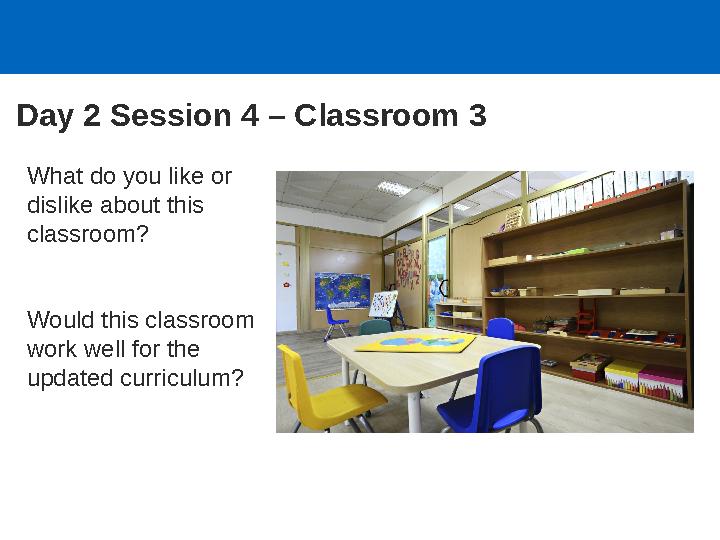
83 слайд
Day 2 Session 4 – Classroom 3
What do you like or
dislike about this
classroom?
Would this classroom
work well for the
updated curriculum?
83 слайд
Day 2 Session 4 – Classroom 3 What do you like or dislike about this classroom? Would this classroom work well for the updated curriculum?
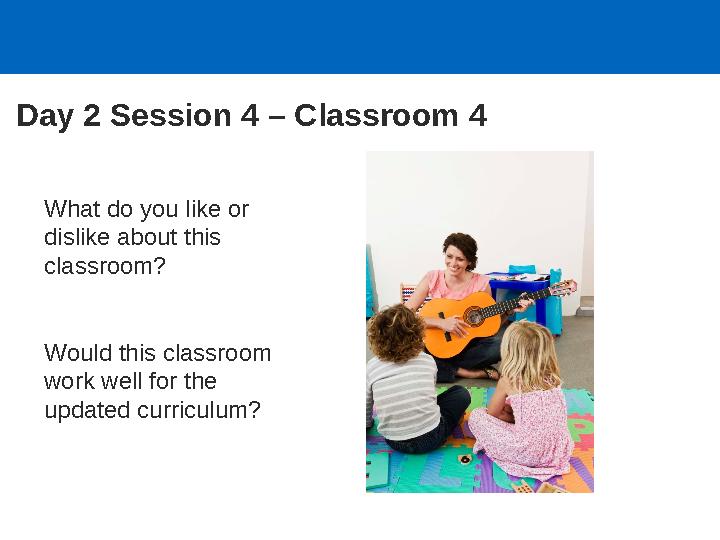
84 слайд
Day 2 Session 4 – Classroom 4
What do you like or
dislike about this
classroom?
Would this classroom
work well for the
updated curriculum?
84 слайд
Day 2 Session 4 – Classroom 4 What do you like or dislike about this classroom? Would this classroom work well for the updated curriculum?
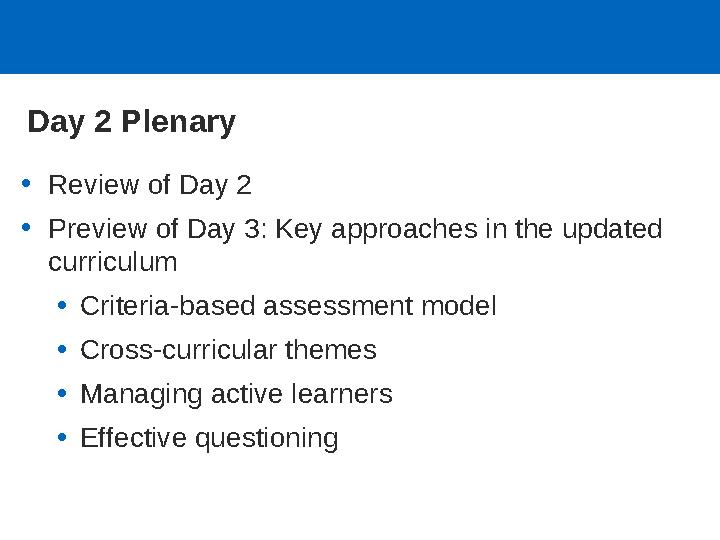
85 слайд
Day 2 Plenary
•Review of Day 2
•Preview of Day 3: Key approaches in the updated
curriculum
•Criteria-based assessment model
•Cross-curricular themes
•Managing active learners
•Effective questioning
85 слайд
Day 2 Plenary •Review of Day 2 •Preview of Day 3: Key approaches in the updated curriculum •Criteria-based assessment model •Cross-curricular themes •Managing active learners •Effective questioning
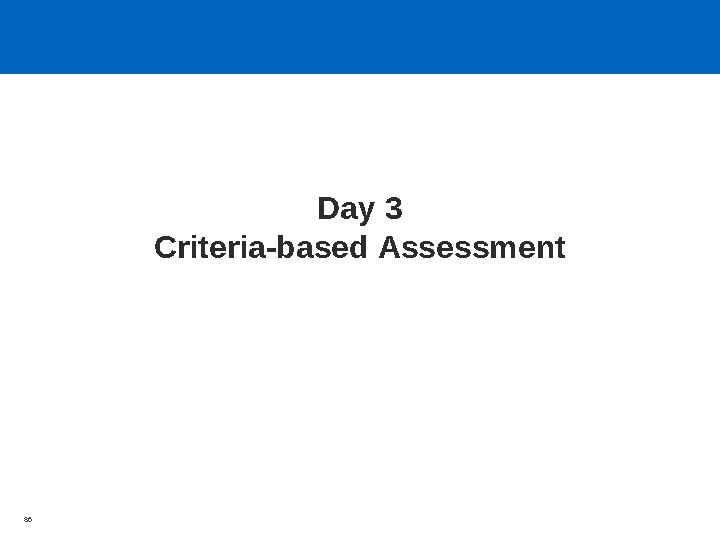
86 слайд
Day 3
Criteria-based Assessment
86
86 слайд
Day 3 Criteria-based Assessment 86
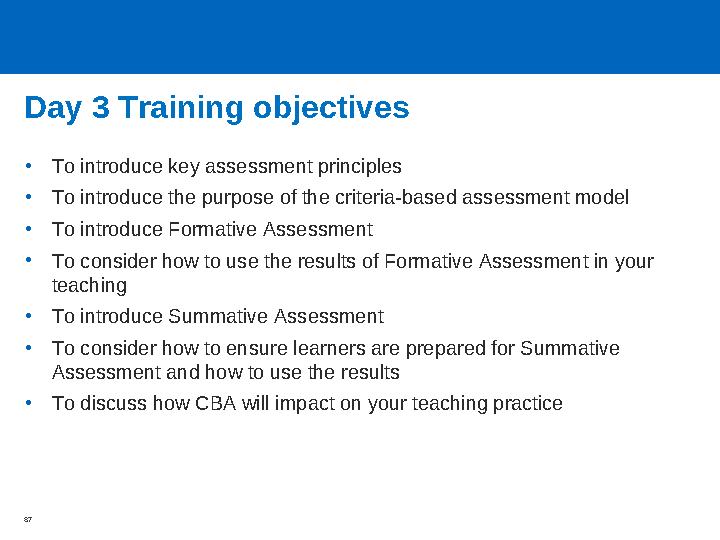
87 слайд
Day 3 Training objectives
•To introduce key assessment principles
•To introduce the purpose of the criteria-based assessment model
•To introduce Formative Assessment
•To consider how to use the results of Formative Assessment in your
teaching
•To introduce Summative Assessment
•To consider how to ensure learners are prepared for Summative
Assessment and how to use the results
•To discuss how CBA will impact on your teaching practice
87
87 слайд
Day 3 Training objectives •To introduce key assessment principles •To introduce the purpose of the criteria-based assessment model •To introduce Formative Assessment •To consider how to use the results of Formative Assessment in your teaching •To introduce Summative Assessment •To consider how to ensure learners are prepared for Summative Assessment and how to use the results •To discuss how CBA will impact on your teaching practice 87
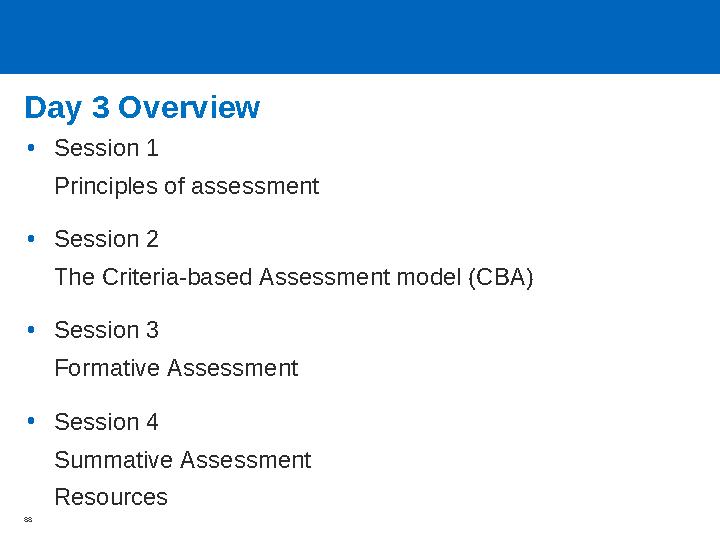
88 слайд
Day 3 Overview
•Session 1
Principles of assessment
•Session 2
The Criteria-based Assessment model (CBA)
•Session 3
Formative Assessment
•Session 4
Summative Assessment
Resources
88
88 слайд
Day 3 Overview •Session 1 Principles of assessment •Session 2 The Criteria-based Assessment model (CBA) •Session 3 Formative Assessment •Session 4 Summative Assessment Resources 88
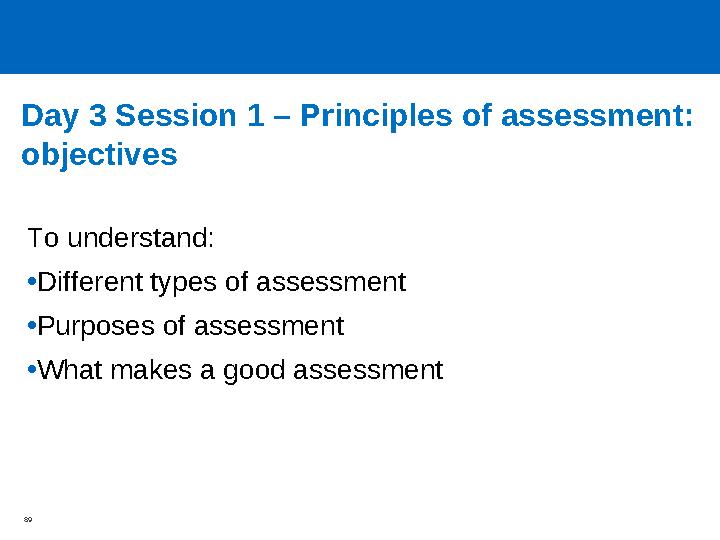
89 слайд
Day 3 Session 1 – Principles of assessment:
objectives
To understand:
•Different types of assessment
•Purposes of assessment
•What makes a good assessment
89
89 слайд
Day 3 Session 1 – Principles of assessment: objectives To understand: •Different types of assessment •Purposes of assessment •What makes a good assessment 89
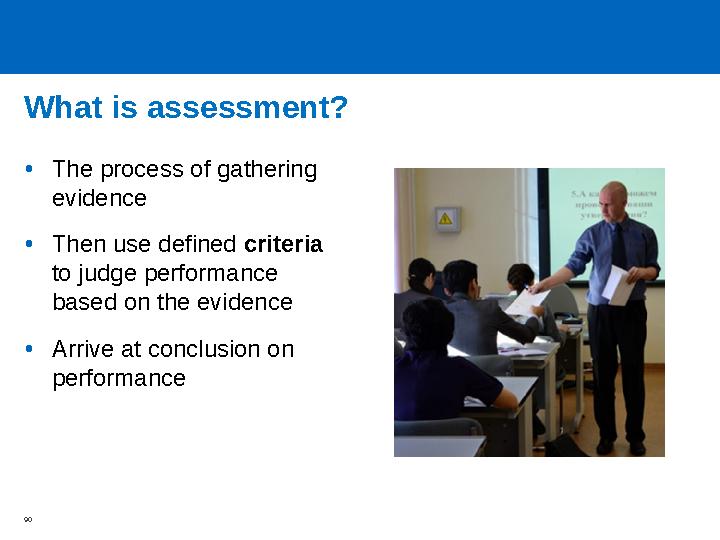
90 слайд
What is assessment?
•The process of gathering
evidence
•Then use defined criteria
to judge performance
based on the evidence
•Arrive at conclusion on
performance
90
90 слайд
What is assessment? •The process of gathering evidence •Then use defined criteria to judge performance based on the evidence •Arrive at conclusion on performance 90
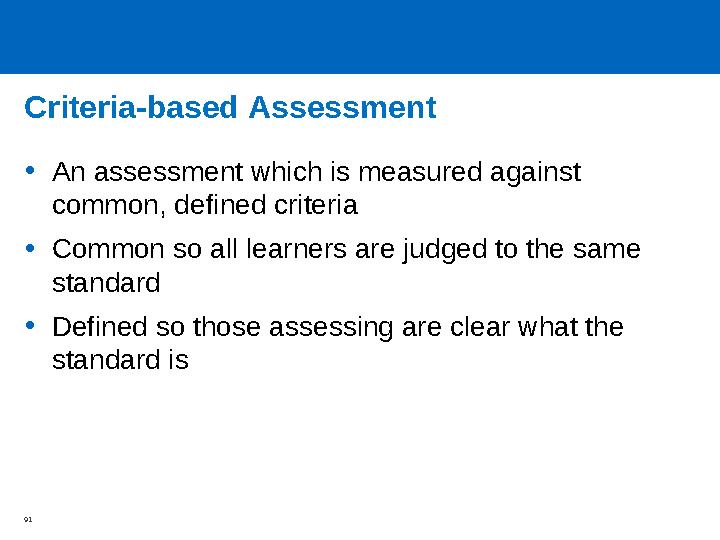
91 слайд
Criteria-based Assessment
•An assessment which is measured against
common, defined criteria
•Common so all learners are judged to the same
standard
•Defined so those assessing are clear what the
standard is
91
91 слайд
Criteria-based Assessment •An assessment which is measured against common, defined criteria •Common so all learners are judged to the same standard •Defined so those assessing are clear what the standard is 91
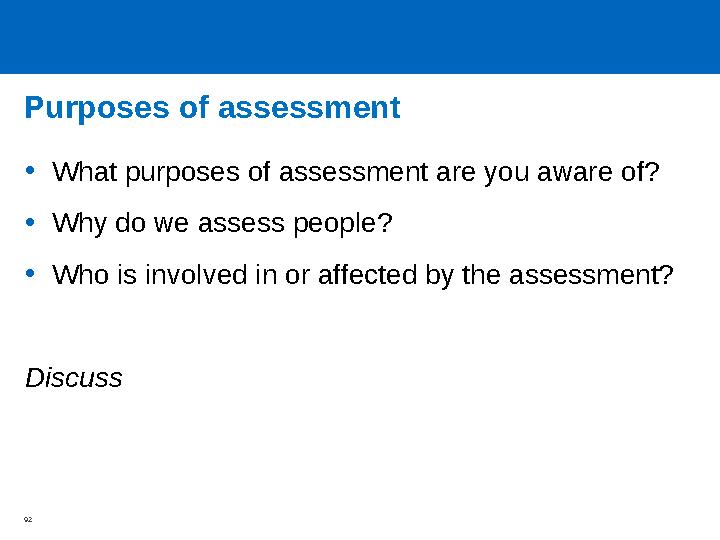
92 слайд
Purposes of assessment
•What purposes of assessment are you aware of?
•Why do we assess people?
•Who is involved in or affected by the assessment?
Discuss
92
92 слайд
Purposes of assessment •What purposes of assessment are you aware of? •Why do we assess people? •Who is involved in or affected by the assessment? Discuss 92

93 слайд
Purposes of assessment
93
progression
at school
qualification
selection
university
entrance
programme
evaluation
monitoring
institutions
motivate
feedback
quality
assurance
93
93 слайд
Purposes of assessment 93 progression at school qualification selection university entrance programme evaluation monitoring institutions motivate feedback quality assurance 93
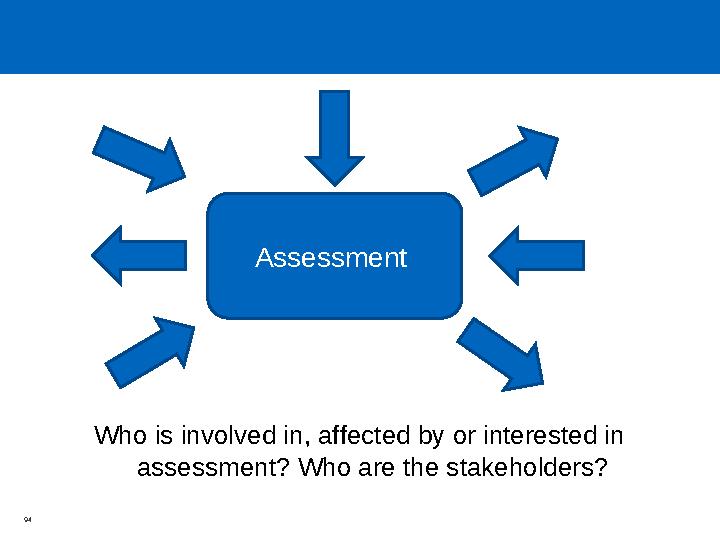
94 слайд
Who is involved in, affected by or interested in
assessment? Who are the stakeholders?
Assessment
94
94 слайд
Who is involved in, affected by or interested in assessment? Who are the stakeholders? Assessment 94

95 слайд
•Learners
•Parents
•Schools
•School administration
•Employers
•Governmental decision-makers
•Society as a whole
•The public’s view of education and learners
•Any more ...?
95
95 слайд
•Learners •Parents •Schools •School administration •Employers •Governmental decision-makers •Society as a whole •The public’s view of education and learners •Any more ...? 95
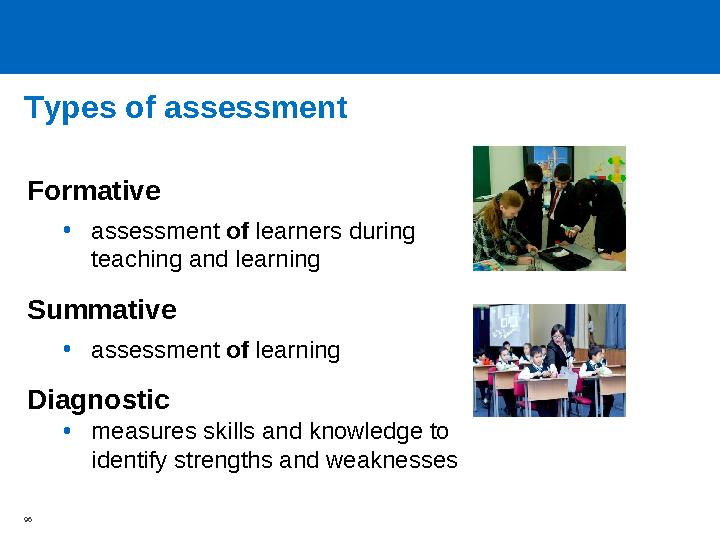
96 слайд
Types of assessment
Formative
•assessment of learners during
teaching and learning
Summative
•assessment of learning
Diagnostic
•measures skills and knowledge to
identify strengths and weaknesses
96
96 слайд
Types of assessment Formative •assessment of learners during teaching and learning Summative •assessment of learning Diagnostic •measures skills and knowledge to identify strengths and weaknesses 96

97 слайд
The Criteria-based Assessment Model
•Guidance for Formative Assessment
•Test Specifications
Activity: What are the differences between
Formative and Summative Assessment?
97
97 слайд
The Criteria-based Assessment Model •Guidance for Formative Assessment •Test Specifications Activity: What are the differences between Formative and Summative Assessment? 97
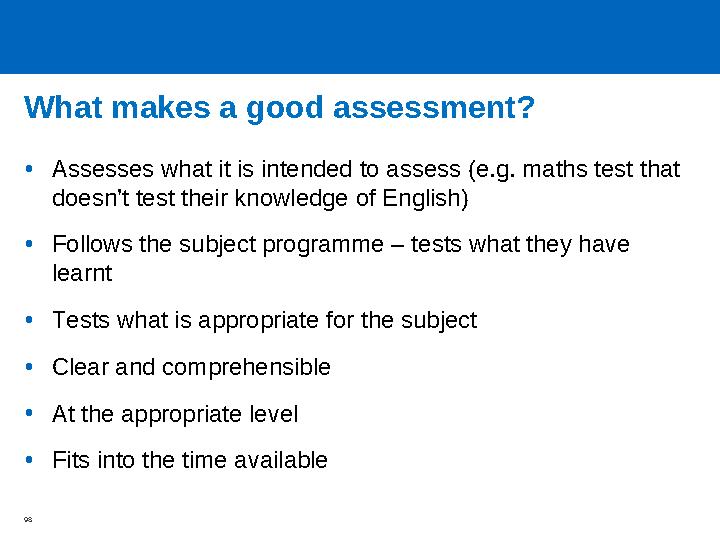
98 слайд
What makes a good assessment?
•Assesses what it is intended to assess (e.g. maths test that
doesn’t test their knowledge of English)
•Follows the subject programme – tests what they have
learnt
•Tests what is appropriate for the subject
•Clear and comprehensible
•At the appropriate level
•Fits into the time available
98
98 слайд
What makes a good assessment? •Assesses what it is intended to assess (e.g. maths test that doesn’t test their knowledge of English) •Follows the subject programme – tests what they have learnt •Tests what is appropriate for the subject •Clear and comprehensible •At the appropriate level •Fits into the time available 98
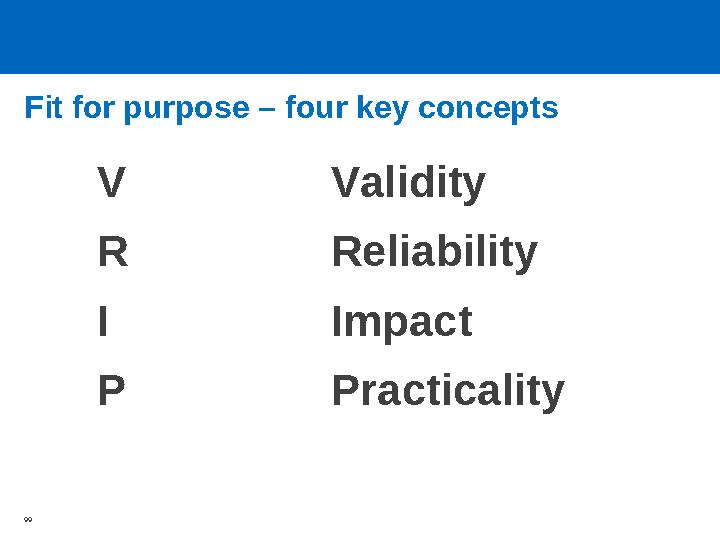
99 слайд
Fit for purpose – four key concepts
V Validity
R Reliability
I Impact
P Practicality
99
99 слайд
Fit for purpose – four key concepts V Validity R Reliability I Impact P Practicality 99
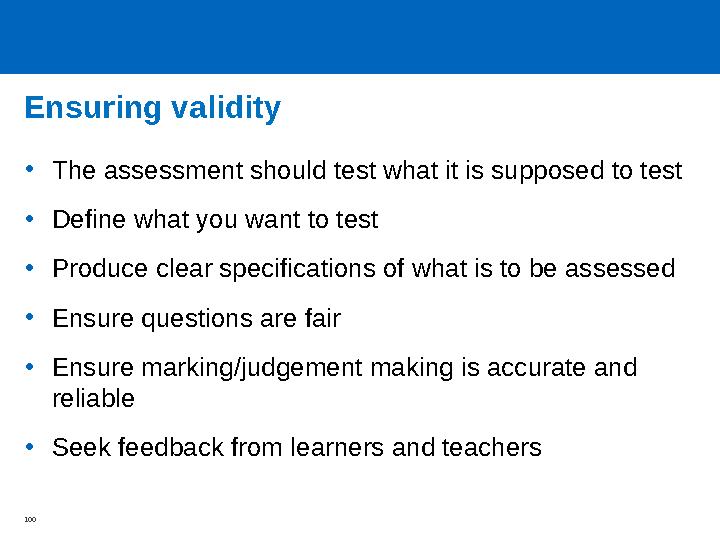
100 слайд
Ensuring validity
•The assessment should test what it is supposed to test
•Define what you want to test
•Produce clear specifications of what is to be assessed
•Ensure questions are fair
•Ensure marking/judgement making is accurate and
reliable
•Seek feedback from learners and teachers
100
100 слайд
Ensuring validity •The assessment should test what it is supposed to test •Define what you want to test •Produce clear specifications of what is to be assessed •Ensure questions are fair •Ensure marking/judgement making is accurate and reliable •Seek feedback from learners and teachers 100
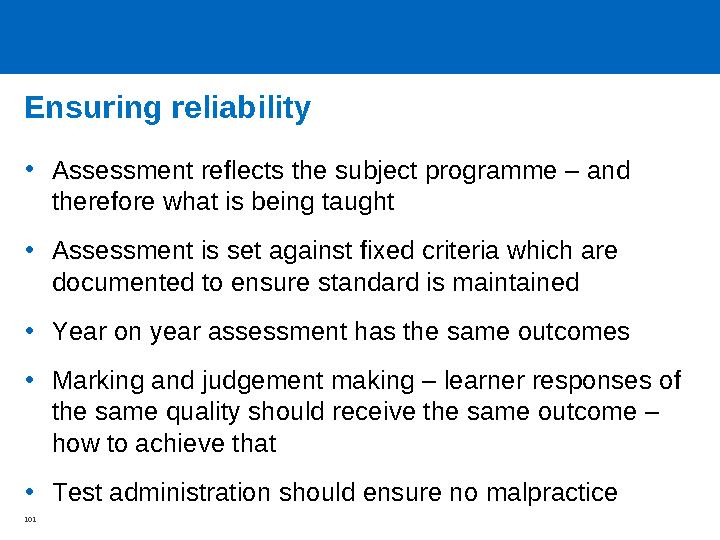
101 слайд
Ensuring reliability
•Assessment reflects the subject programme – and
therefore what is being taught
•Assessment is set against fixed criteria which are
documented to ensure standard is maintained
•Year on year assessment has the same outcomes
•Marking and judgement making – learner responses of
the same quality should receive the same outcome –
how to achieve that
•Test administration should ensure no malpractice
101
101 слайд
Ensuring reliability •Assessment reflects the subject programme – and therefore what is being taught •Assessment is set against fixed criteria which are documented to ensure standard is maintained •Year on year assessment has the same outcomes •Marking and judgement making – learner responses of the same quality should receive the same outcome – how to achieve that •Test administration should ensure no malpractice 101

102 слайд
Impact
This is the effect the test has on:
•Teachers and learners
•Parents
•Teaching and learning
•Educational systems
•Society in general
102
102 слайд
Impact This is the effect the test has on: •Teachers and learners •Parents •Teaching and learning •Educational systems •Society in general 102
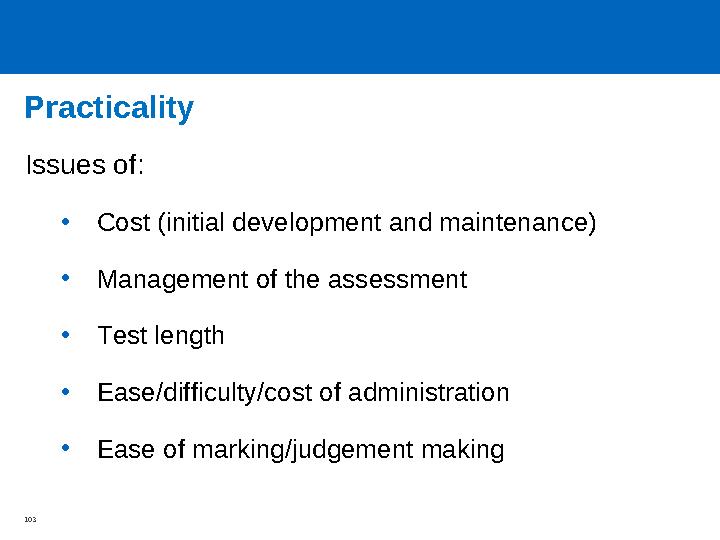
103 слайд
Practicality
Issues of:
•Cost (initial development and maintenance)
...
103 слайд
Practicality Issues of: •Cost (initial development and maintenance) ...















